Wild About Berries GARDEN SUPERFOODS

Bonne Fête des Mères !
A Brief History
















































































CONTACT US:
Tel: 05 17 36 15 32
email: editors.etcetera@gmail.com
website: www.etceteraonline.org 17 rue des Chaumettes 86290 St Léomer
etcetera magazine @etceterafrance
Welcome to the May edition of etcetera magazine.
This month is particularly well known in France for its numerous jours fériés and, fingers crossed, warm weather. Lots of artistic events are happening this month for us all to enjoy, as well as supporting local artists.
We welcome two new contributors to the writing team! They all play an important role in this magazine, providing us with new and relevant content every month.
Wishing you all a fantastic month ahead.

15 SAMU (Medical)
17 Gendarmes (Police)
18 Pompiers (Fire and also trained in medical emergency)
112 European emergency not always English 114 Text-message emergency number for deaf/hard of hearing
119 Child abuse
115 Homeless
113 Drugs and alcohol 1616 Emergency- Sea & Lake
Annual subscription
France/EU only 55€ Card payment by telephone

Commercial adverts: Please see our Media Pack at www.etceteraonline.org
What’s On/Listings: 12€ per 50 words for a guaranteed spot or free (space permitting)
Classified listing: 6€ per 25 words plus 3€ per photo
Property listing: 10€ per 50 words plus 6€ per photo
Code APE 5814Z Edition de Revues et Periodique Siret 80903463000016. La Présidente G. Feasey
Registered. Le Bourg, 87360 Verneuil Moustiers. Impression: Rotimpres. Pol. Ind Casa Nova. Carrer Pla de l’Estany s/n. 17181 Aiguaviva (Girona) Espagne. etcetera est gratuit.
While we always do our best to ensure the content in this magazine is given in good faith and businesses are reputable, we accept no liability for any errors or omissions and do not endorse any companies, products or services. Articles written are the personal opinions of the original authors and do not necessarily reflect the views of etcetera magazine.

3131 Last incoming call, key ‘5’ to connect Orange
English speaking helpline
0033 (0)9 69 36 39 00
Website in English: www.orange.com/en/home
Technical assistance for landlines (French): 3900 (+33 9 69 39 39 00 from abroad)
SFR 1023 or 00336 1000 1023 (Not English)
EDF 8am to 8pm, Monday to Saturday. +33 (0)9 69 36 63 83 EDF Helpline in English 0033 562164908 (From UK)
E-mail: simpleenergywithedf@edf.fr
CPAM - 09 74 75 36 46
Veolia Water Emergency No: 24h/24 et 7j/7 05 61 80 09 02 (press 1 for urgent problems or 2 for a technician)
S.E.P Du Confolens (Water)
05 87 23 10 08 Emergency 24/7
Aéroport Int’l Limoges 05 55 43 30 30
SNCF (train times, buying tickets etc) 36 35
Credit Agricole English Speaking Helpline
Charente (residents only) 05 45 20 49 60
Alcoholics Anonymous
For contact details of meetings in your area including those conducted in English, visit www.aafrance.net
SSAFA France 05 53 24 92 38 email france@ssafa.org.uk
HOSPITALS
05 55 05 55 55 Limoges (CHU)
05 55 43 50 00 St Junien
05 55 47 20 20 Bellac
05 49 44 44 44 Poitiers
05 45 24 40 40 Angoulême
05 49 32 79 79 Niort
05 45 84 40 00 Confolens
Bereavement Support Network
English speaking support group for guidance on coping with bereavement in France. Personal and practical advice. www.bsnvar.org
Women for Women in France offering support to foreign-born (non-French speaking) women dealing with domestic abuse www.womenforwomenfrance.org
Counselling In France Counsellors, psychotherapists, NLP, CBT etc offering therapy in English to expatriates all over France on www.counsellinginfrance.com
French Health Insurance Advice line
CPAM English speaking Advice line: 09 74 75 36 46 (from France)
0033 974 75 36 46 (from other countries). The line is open from Monday to Friday, from 8:30 a.m. to 5:30 p.m.
NHS website : www.nhs.uk/using-thenhs/healthcare-abroad www.ameli.fr
No Panic France Helpline: No Panic UK helpline: 0044 1 952 590 545 11h - 23h (French time) 7/7 www.nopanic.org.uk /nopanicfrance@orange.fr
English-speaking Mental Health Line
SOS- HELP 01 46 21 46 46 3pm-11pm 7/7
British Consulate in Paris 01 44 51 31 00
British Consulate in Bordeaux 05 57 22 21 10 www.ukinfrance.fco.gov.uk/en/























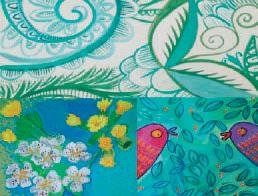




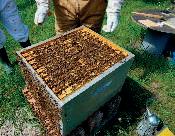

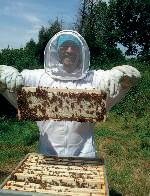



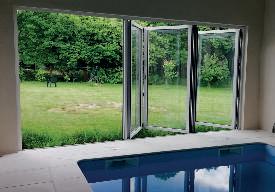





MAKING CARDS USING A TEMPLATE IS A GREAT WAY TO CREATE WHATEVER SHAPE YOU WANT AND THEN LET YOUR IMAGINATION FLOW!

If you’re looking for some inspiration for a simple Mother’s Day card try this easy yet effective card! Only a few materials are needed, and it suits both young and old crafters. If you prefer, try different shapes for your tree, just make the template, choose your colours and then get creating!
Steps

1. First you need to make the heart template. Work out how big you want your heart to be on the card. Then take a piece of paper and fold it in half, draw half a heart, and when you’re happy with the shape cut the shape out. You are now left with a piece of paper with the cut out shape inside, this is your template.
2. Now take your card, and position the heart template on the front. It’s a good idea to secure it so it doesn’t move around as you’re working. Within the shape of the heart, take
Materials
1 sheet of white paper or thin card (template)
Plain white card
Ink pads or paints– choose your colour scheme
Black or brown marker
Scissors
Pencil (optional, to draw a light outline)
your marker pen and draw the silhouette of the tree.

3. Take your paints or ink pads, and start adding your fingerprints within the template area - as few or as many as you wish!
4. Remove the template and, if you want to, draw the rest of the trunk of the tree.




Other ideas… you could make this into a picture for a frame, or cut the shape out and hang it!












view our collection, please visit our FB page: www.facebook.com/bespokedenise.eyre or website www.bespokebydenise.com













THESE DAYS, MOTHER’S DAY IS A RELATIVELY SIMPLE CONCEPT – A DAY TO REMEMBER, TO RECOGNISE, AND TO THANK OUR MOTHERS FOR ALL THE WONDERFUL THINGS THEY DO IT HAS CHANGED. NOW LET
US LOOK AT A CALMER PERIOD, AND WHAT THE DRAWBACKS WERE
 By SamFerguson
By SamFerguson
Sam is a crafty and creative Dordogne resident since 2014. When not knee deep in glitter & glue with the kids, she loves to write and share her experiences with others exploring this part of France

Fête des Mères
Sunday 26 May 2024
W
e acknowledge the sacrifices they make and the aspects of themselves that they might leave behind in their journey to mould us into fully-grown humans. They love us, feed us, teach us, clean and cook, they look after our physical and emotional needs and offer a lifetime of emotional support. Those are just a few of their most obvious roles, and oftentimes whilst also working full-time jobs.
So, it is easy to see what makes mothers so incredible, and worth celebrating. But even as I start writing, origins aside, I am immediately aware of the complexities of Mother’s Day. Just two words in, and I am questioning … where do I put my apostrophe? Don’t worry, keep reading and we’ll come to that!
So what are the origins of Mother’s Day?
If you have ever wondered why France, the UK, or the USA amongst others, celebrate Mother’s Day on different dates, it is because their origins are not all the same. Although there is a common theme to most celebrations now, historically they were all quite varied.
The first traces of Mother's Day can be found in Greek mythology when goddess Rhea, the mother of Zeus, was honoured in spring. In the Middle East, most countries celebrate the holiday on 21st March, which is the spring equinox.
In the UK, ‘Mothering Sunday’ has its origins as early as the 16th century. The date each year is established based on the church calendar, and falls three weeks before Easter on the fourth Sunday of Lent.
At its origin, it was tradition once a year to visit the church where you were christened or your parish church (your ‘mother’ church). Servants were given the day off to return to the parish where they were born. Children as young as 10, who had often left home themselves to work, would also come on this special day. The tradition of gathering of wildflowers on route is still
reflected in the floral gifts we give today, and despite falling during Lent, normal restrictions were traditionally relaxed, and mothers were also treated to delicious cakes, such as simnel cake, mothering buns or fig pie.
As opportunities for family get-togethers were few and far between, it became a very special day. Over time, the focus of the day shifted from the ‘mother church’ to the mother herself.
The French celebrate “La Fête des Mères” each year on the last Sunday in May, or if Pentecost falls on that date, then the first Sunday in June. This year it will fall on the 26th May.
It is said to have been proposed by Napoleon Bonaparte in 1806 as a way to encourage mothers to have more children. It wasn’t formally recognised by the government however, until 1920 when the administration began handing out the Médaille de la Famille, an honorary distinction awarded to people who “raise or who have raised numerous children with dignity, in order to pay tribute to their merits”. In 1950 a special law was created to dedicate Mother’s Day as an official tribute to mothers.
also promoted a "Mother’s Peace Day" much earlier in 1872 as part of her antiwar efforts, it was Jarvis who began the campaign to have Mother’s Day officially recognised. President Wilson apparently heard of Anna's work, and Mother's Day officially became a national holiday in 1914 to be celebrated in the USA annually on the second Sunday in May.
Anna was very clear that the day was not about celebrating all mothers. Rather it was to celebrate the best mother you've ever known - your own mother - hence Mother’s Day (apostrophe S), and not Mothers’ Day.
Over time, the focus of the day shifted from the ‘mother church’ to the mother herself
Despite being credited with its creation, in later years Anna Jarvis spoke out against the commercialisation of the day and resented its transformation from ‘intimate Mother's Day’ to ‘commercial gold mine’. It was in fact likely that the American soldiers stationed in France during World War I, helped bring many commercialised Mother’s Day traditions from America - like flowers, cards, and gifts - to France.
Many countries share this second Sunday of May celebration, including India, New Zealand, Australia, and Sri Lanka.
In the USA, Mother’s Day is a much more recent concept, credited to Anna Jarvis in 1908 following the death of her own mother in 1905. Anna’s mother, Ann Reeves Jarvis, organised Mother's Day work clubs to help improve sanitary conditions, in an effort to lower high infant mortality rates. Post war, she organised events such as Mother's Friendship Day picnics to bring people together and promote peace.
Anna’s first Mother's Day function was on 10th May 1908 in her hometown of Grafton, West Virginia. And whilst social justice advocate Julia Ward Howe, writer of "The Battle Hymn of the Republic," had
The mothers we celebrate on this day are now reflected in our changing times with many people celebrating multiple mothers, including step-mothers, godmothers, foster-mothers, adoptivemothers, and mothers in same sex partnerships, as well as remembering those we have lost.
So, to all mothers everywhere, enjoy one (or more!) of the Mothering Sundays around the world, and depending on how many mothers you are celebrating on this special day, I will let you decide where to put your apostrophe!
Bonne Fête des Mères!
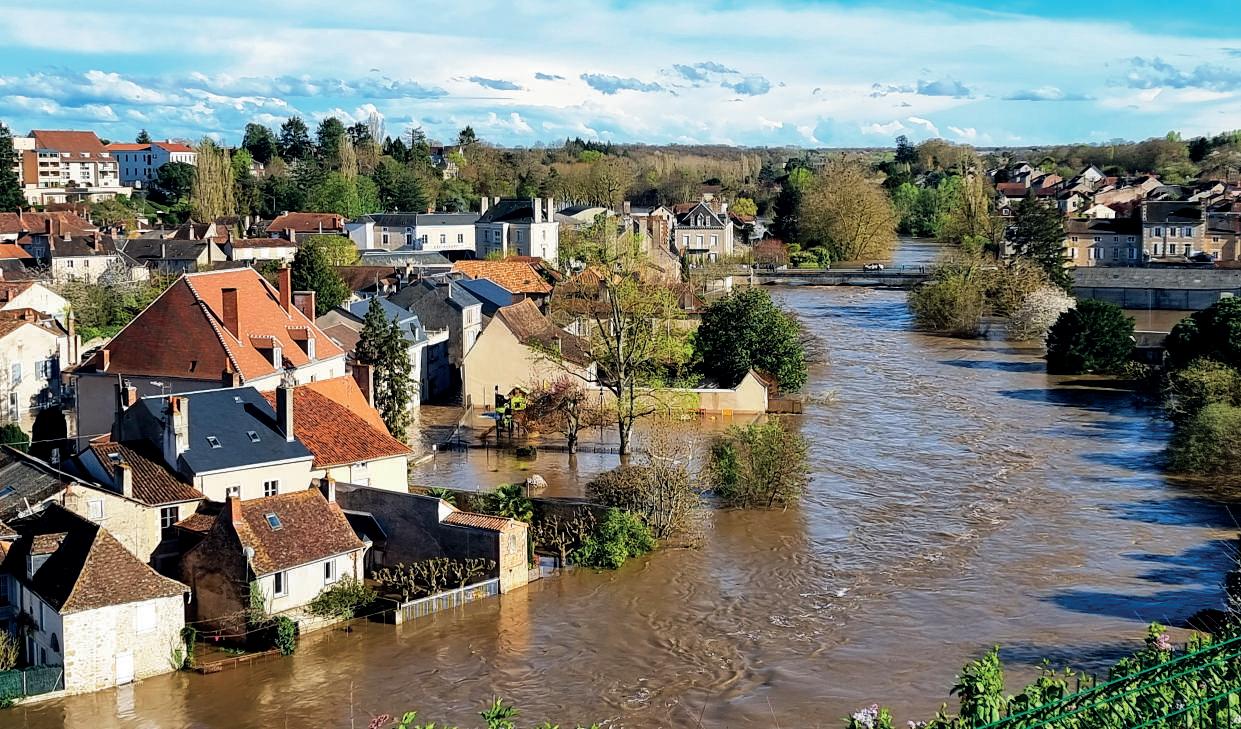
WE HAVE SEEN A FAIR BIT OF FLOODING IN THE LAST FEW MONTHS AND THE EASTER WEEKEND SAW SOME RIVERSIDE TOWNS BADLY HIT
Several times I’ve looked out of my window down into the valley and thought, “Poor old Bernard’s fields are under water again”, as the Charente has overflowed its banks for the umpteenth time. But this is a relatively gentle event, caused by a warm winter and an unusually high rainfall as a result. It is possibly annoying to Bernard if he wants to winterplough, but not very much of a threat otherwise, and at least the fertility of his fields will be enhanced. You see, all rivers have floodplains, for the very reason that they overflow relatively often. The trouble comes when people get the bright idea of building houses on those floodplains. The flood may not happen for years and years, but it will eventually! My little village of Budleigh Salterton on the Devon coast has
a long floodplain at the mouth of the Otter River, which flows through it. It is the ideal place for a cricket pitch - flat and dry in summer. In winter, the clubhouse has been known to disappear until only its roof-ridge shows above the water.
The clubhouse has been known to disappear until only its roof-ridge shows above the water
Much of so-called ‘area flooding’ has to do with the local water table. For those of you not familiar with that term, this is the local level of water in the surrounding terrain. Normally, the top of this waterload is below the level of the soil. It is this that anyone trying to dig a well is searching for. If you have difficulty finding water for your well, you may be relatively safe from flooding. If, however, you strike water a foot or two below the soil level, you could have a problem!
 ByMikeGeorge
ByMikeGeorge
Mike George is our regular contributor on wildlife and the countryside in France. He is a geologist and naturalist, living in the Jurassic area of the Charente
When excessive rainfall raises the water table until it is at or above ground level, local flooding can occur. This is what tends to happen in low-lying places such as Saint-Fraigne near Aigre in Charente, which throughout winter displays with pride its water gardens (jardins éphémères), where the river Aume floods for several months in the winter, converting the floodplain into a small series of islands.
When a river flood happens, it may be caused by a sudden excessive influx of water. This can be caused by unusual meteorological events such as intense and prolonged rainfall on a limited area, such as caused the extreme floods in Lynton and Lynmouth, Devon, in 1952, or the Boscastle, Cornwall, flood in 2004. Such floods can be very damaging but tend to be short-lived. Practically all the parked cars

in Boscastle ended up in the bay, and no spells could save the Witchcraft Museum!
The floods that cause real damage, and entail serious loss of life, are those that are caused by unexpected geological phenomena. I am sure we all remember the dreadful Boxing Day tsunami in the Indian Ocean margins in 2004. Here a section of a fault under the ocean moved significantly, causing a surge in the ocean only a few feet high, but which, when it impinged upon the shallowing coast, rose to a wave which was up to 100 feet high and rapidly engulfed the low-lying coastal region. The death toll exceeded a quarter of a million people in 20 countries, and the damage to property was vast. A tsunami is by no means a rare phenomenon. The word is Japanese for ‘harbour wave’, and we saw a Japanese home-grown example at Fukushima in 2011. Here the most significant casualty was the nuclear power plant, which had been designed with inadequate flood planning (its controls were below ground level) and consequently it was badly damaged and caused a nuclear alert. In the Scilly Isles there is a volcano that is threatening to collapse into the Atlantic. Meteorologists and geologists on the Eastern Seaboard of America are quite worried about this, as if it all falls at once it will create a tsunami-like wave that will reach America. It may well affect the coasts of Northern Europe as well.
Storm surges are another cause of coastal flooding. These are more common, and there may be marginally more warning, but they are equally hard to combat. Such surges usually occur when strong winds and heavy rain combine with an unusually high tide to drive the sea up the river estuaries to meet heavy flood water coming down the rivers. Excessive coastal flooding is inevitable unless preparatory measures have already been taken. Sadly, these measures are usually of low priority, as storm surges are not an everyday experience, being relatively uncommon and, in the long term, unpredictable.
Urban flooding is the sort that gets into the papers and on the news most regularly. The trouble with urban areas is that bare earth is not generally welcome. Paved areas to walk on, metalled roads to drive on, roofs to keep the insides of buildings dry, all combine to cause rainwater to run in different directions rather than soaking gratefully into the waiting earth. These days storm drains are usually incorporated into gutters but there is a limit to how much they can cope with. When a river gets involved as well, the results can be spectacular.
Choosing Where to Live
So how do you avoid getting involved in flooding? Well, to some extent you use
your common sense! If you are buying a new home, think ‘disaster’. It is very pleasant in summer to sit beside a gurgling stream with a drink in your hand and a kingfisher flying up and down, but consider how far the stream would have to rise in a protracted rainstorm before it was pushing at your door. Look in the trees and hedges for debris. When I first moved to Devon, I went house hunting. One of the first houses I visited was in a pretty little valley with a stream running through the back garden. I asked about flooding and was told it was not a problem. On my way out I looked in the trees by the roadside and saw small bundles of twigs and dried leaves caught in the branches at about ground floor window level. I quietly put a cross by that address!
rain, which is what happened at the end of March. Then the river will swell and push itself up any side-channels, which we know exist in Montmorillon, and flood low-lying parts of the town. The main parts of Montmorillon and Bellac seem high enough above river-level, but the commercial parts of these towns tend to be nearer the river level for obvious reasons (simpler access to watertransport) so these are the areas that get flooded.
The word is Japanese for ‘harbour wave’, and we saw a Japanese homegrown example at Fukushima in 2011
Don’t, by the same token, be tempted into buying a home on a river floodplain. The soil will be very fertile from the sediment that lies on it, there will be a river (probably a considerable one) in sight, and no hills to climb. Most pleasant! There will also be a distinct chance of flooding in a rainy year, and don’t let anyone ‘poohpooh’ your concerns!
And don’t choose a home downstream of a large dam.
So What Caused Our Recent Floods?
Of course, uppermost in everyone’s mind are the floods in northern Aquitaine. I have been looking at what could have happened in Confolens, Bellac and Montmorillon. They all seem to be of a similar situation - built on a narrowed large river, and with old-style bridges that partially block the river's free flow. This is not normally a problem unless you get flash-flooding after concentrated, heavy
Also there seems to be a fair bit of building in Bellac on the floodplain of the Vincou. Those places would have been seriously affected. I am familiar only with the centre of Montmorillon, but judging by the map there is a lot of housing upstream of the town with nice houses with gardens running down to the river. That is a recipe for disaster, especially when you are upstream of narrow bridges that back-up floodwater.
It is always difficult to say exactly what happened in any natural disaster, especially if one was not present, and certainly prediction of such events recurring is notoriously unreliable. I believe there was some similar flooding took place at the end of the 1980s, so it is a problem that may well recur, and with increasing frequency if the prognostications of the climate experts are fulfilled.
We all have to live with the possibility of flooding, but for peace of mind, make sure you live several tens, or even hundreds, of feet above the local river or the sea’s high water mark. Then, if the water flows past your home, it will keep going – unless an ark chances to float past too!
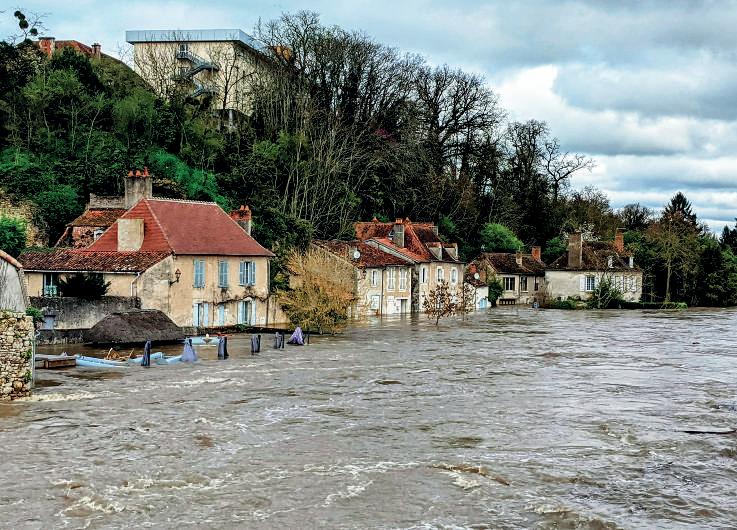
En cette période de printemps, nous avons tous envie de sortir.
Pourquoi ne pas nous faire beaux ?!
In springtime we all want to get outside. Why not make ourselves beautiful?!
Voici un peu de vocabulaire et des verbes dans des phrases sur les thèmes des vêtements, des bijoux et du maquillage.
Here are some vocabulary and some verbs in sentences on the theme of clothing, jewellery, and makeup.

Clothes
porter to wear (or to carry)
Elle porte un T-shirt
She wears / she is wearing a T-shirt s’habiller to get dressed
Je vais m’habiller
I am going to get dressed se déshabiller to get undressed
Je ne vais pas me déshabiller
I am not going to get undressed
être habillé (e) to be dressed
Il est habillé en bleu
He is dressed in blue mettre (un vêtement) to put on (a piece of clothing)
Je mets ma chemise
I put my shirt on

nouer to tie / to make a knot
Il noue sa cravate
He ties his tie boutonner to button up
Je boutonne mon pantalon
I am buttoning up my trousers déboutonner to unbutton
Il déboutonne sa chemise ! He is unbuttoning his shirt! remonter ses manches to roll up one’s sleeves
Je remonte mes manches I roll up my sleeves à l’envers inside out

enlever to take off
Il fait chaud, je vais enlever mon pull
It is warm, I am going to take off my jumper enfiler to slip on
Je vais enfiler ma jolie robe
I am going to slip my pretty dress on
la tenue the outfit / dress
Il est en tenue de soirée
He is in formal dress
Je ne suis pas en tenue décontractée
I am not in casual dress.
attacher
to attach / to fasten / to tie
J’attache mon soutien-gorge
I fasten my bra
J’attache ma ceinture
I buckle my belt
Ton pull est à l’envers
Your jumper is inside out. à l’endroit the correct way round
C’est mieux maintenant, ton pull est à l’endroit
It is better now, your jumper is the correct way round assorti (adj) matching
Mes chaussettes ne sont pas assorties
My socks do not match. ouvert (adj) opened
Oh, ta braguette est ouverte
Oh, your flies are undone bien habillé (e ) well dressed
Je suis toujours bien habillé
I am always well dressed mal habillé (e ) badly dressed

Il est toujours mal habillé
He is always badly dressed mettre ses chaussures = se chausser to put on your shoes
Le matin, je mets mes chaussures In the morning, I put my shoes on enlever ses chaussures = se déchausser to take off your shoes
Le soir, j’enlève mes chaussures In the evening, I take my shoes off faire ses lacets to tie your laces
L’enfant doit faire ses lacets tout seul
The child must tie his own laces cirer ses chaussures to polish one’s shoes
Il est important de cirer nos chaussures
It is important to polish our shoes aller to go / to fit / to suit
Cette jupe te va bien This skirt suits you
Un bijou a piece of jewellery
jewellery mettre to put on
Je mets des boucles d’oreille I put some earrings on
Je mets un collier I put a necklace on porter to wear
Je porte une bague avec un diamant I am wearing a ring with a diamond
Il porte toujours une montre He always wears a watch enlever to take off
Le soir, j’enlève mes bijoux In the evening, I take off my jewellery
Makeup se maquiller to put makeup on
Je me maquille tous les matins I put makeup on every morning
Prenez soin de vous ! Take care ! Bon courage ! Et à bientôt ! Isabelle
Élargissez vos horizons avec CONTINENTAL HORIZONS ! Broaden your horizons with CONTINENTAL HORIZONS! Isabelle works for CONTINENTAL HORIZONS Language Centre in L’Isle Jourdain 86. She is a specialist Teacher of French as a Foreign Language with more than 26 years’ experience. Do not hesitate to contact her on 06 20 10 34 49 or 05 49 84 17 73
Learn French with Continental Horizons! Contact us by email : continentalhorizons@free.fr

appliquer to apply (onto)
le fond de teint foundation cream
J’applique un fond de teint sur mon visage
I apply a foundation cream on my face. la poudre powder
une houpette a powder puff
J’applique de la poudre avec une houpette. I apply some powder with a powder puff mettre to put on
Je mets du mascara noir sur mes cils
I put some black mascara on my eyelashes. utiliser to use

450 833 009 00027

with experienced French teachers (if eligible) Groups - Private tutoring - E-learning

souligner to underline
un crayon a pencil
un eye-liner an eye-liner
J’utilise un crayon ou un eye-liner pour souligner mes yeux
I use a pencil or an eye-liner to underline my eyes.
une ombre à paupières an eye-shadow
Je mets de l’ombre à paupières
I put some eye-shadow on. un rouge à lèvres a lipstick
Je n’oublie pas de mettre du rouge à lèvres
I don’t forget to put some lipstick on.
ONE-TO-ONE / GROUPS
At Dino’s in Champagnac la Rivière (87150) or ONLINE CLASSES

Contact Alain 05 55 32 41 76 / 06 37 76 54 98 alain.rio@hvformations.org http://hvformations.org

Siret: 824417364 00018

r.sandrine.durand@orange.fr PLUS
Translations & Administrative Assistance
Sandrine Durand Siret









Iimagine every city around the world has a unique character, its own ‘vibe’. It might be intriguing architecture, great food or a vibrant cultural centre; maybe an indefinable ‘attitude’ we see in its locals. In my experience, however, if we’re talking unique, none can match Berlin. Because Berlin had The Wall.
In my 1960s’ childhood the TV news would mention the name “Checkpoint Charlie” and words like “Soviet” and “espionage”. As I understood more, I assumed Berlin must lie in the middle of Germany so that the contentious East/West dividing line – the so-called “Iron Curtain” - passed through its centre. Later, of course, I realised the city actually stood deep inside the Communist East, split in two by a giant wall which imposed ruthless authoritarianism and shattered families. In August 1961 people woke to find their children and grandchildren now lived on the other side of barbed wire which had been rolled out overnight and was soon replaced by concrete blocks, armed sentries, and watchtowers. Intended to halt the exodus of skilled workers and academics to the West, the wall’s unusual function was thus not to keep intruders out but to trap its own citizens in. Over the 28 years of its existence around 140 people died trying to cross the Berlin Wall, many of them shot by border guards.
Unlike Berlin, walls elsewhere have mostly been built as a defence against outsiders. Emperor Hadrian oversaw the construction of a coast-to-coast barrier across northern England because not even the sprawling Roman Empire fancied its chances against the Scots. China’s Ming Dynasty built the mother of all walls to keep out marauding tribes from its northern borders. It’s 5000 km long but, contrary to popular myth, it is not visible from space.
Fixating on differences between us is as much part of human DNA, it seems, as the need to sleep
More recently, Belfast has its “Peace Walls” which, despite the 1998 Good Friday Agreement, still segregate Catholic and Protestant areas of the city. In places they are three times higher than the one in Berlin and although many have been removed, the last one was erected as recently as 2018. In the Middle East, the “Green Line” is the site of a complex system of walls and fences built by Israel as what it described as a necessary bulwark against Palestinian political violence. The United Nations has described the construction as a violation of international law.
Fixating on differences between us is as much part of human DNA, it seems, as the need to sleep. We mark out these borders and erect our walls; we construct the frontiers and barricades which make conflict inevitable. Yet still we build.
We visited Berlin twenty years after the wall’s demise but it still felt awkward to be a tourist where such anguish had once existed. Sections of the four-metre-high wall remain and in Potsdamer Platz stones are set into the ground along its former path. At Checkpoint Charlie, where nervous Soviet and American tank crews had once stared down each other’s gun barrels while the world held its breath, we enjoyed coffee in the sunshine. Faux-Soviet-era souvenirs were on sale. It was all vaguely surreal.
Donald Trump’s headline campaign promise in 2016 was to end what he called the flow of illegal immigrants and drugs across the USA’s southern border. He not only pledged to build a wall along the entire 2000-mile boundary but also, somewhat implausibly, to force Mexico to pay for it. Millions fell for Mr Trump’s bombast, believing in his two promises but – spoiler alert – he kept neither.
Crucially, walls require an enemy, real or imagined, from whom the people need
Brian White lives in south Indre with his wife, too many moles and not enough guitars

protecting. Sometimes that threat must be exaggerated. During those Cold War years, for example, the Pentagon’s trillion-dollar budgets from Congress depended on the American public being kept afraid of the Communist menace. The people were less informed, however, about the massive loans to East Germany facilitated by major US banks. America was propping up Communism financially because it needed it to exist just as much as the failing Eastern economies needed the cash.
Whole political careers are built on promising these simplistic fixes - like building a wall - to fiendishly complex problems. Turn us against each other, identify and demonise some group of “them” without whom life would be so much better, and you can ride the resulting wave of anger all the way into power. Manufacturing and channelling public outrage can also save you, quite neatly, from the responsibilities of actually having to govern.
And . . . breathe. Sorry, don’t mind me –I’ll switch to decaf. Anyway, it all brings to mind a poem I read years ago. In “Waiting for the Barbarians” the Greek writer Constantine Cavafy describes a frightened population trapped inside their city, convinced of an imminent attack by outlaws they believe to be massing outside the walls. One day some travellers arrive from a neighbouring land and assure the people that no such threat exists.
The narrator of the poem is bewildered, “And some of our men just in from the border say there are no barbarians any longer. Now what will become of us without the barbarians? They were a kind of solution.”



This month I am going to take you through three main know-hows of Mexican food, more specifically, tacos. Other than the fresh, vibrant, and flavourful dishes that come with tacos, the next best part is how flexible they can be. Here we will have two filling recipes and the meat seasoning(s), plus a traditional Mexican dessert.
When making tacos you can use flour tortillas, corn tortillas, or make it nachos by serving over tortilla chips.
Other than the fresh, vibrant, and flavourful dishes that come with tacos, the next best part is how flexible they can be
The essentials of a taco are wrapper, protein, and fillings. You can’t go too big or too small with ingredients. Example fillings are pico de gallo/salsa, guacamole, cheese, lettuce/cabbage, jalapenos, sour cream/avocado cream, etc. I recommend having coriander leaves and lime juice in all of your tacos. Experiment these fillings with your favourites vegetables, meats and fish and get taco making!
I look forward to sharing my recipes and knowledge with you.
This recipe, like salsa, has few ingredients so they are all key players.
INGREDIENTS (SERVES 4-6)
4 avocados
2 medium shallots
1 bunch of coriander
2-3 limes
Sea salt
Fresh medium grind black pepper
METHOD
1. Trim the tops from the shallots, clean thoroughly. Dice the shallots very, finely and add to a bowl. (As a trained chef, I use the brunoise method in my kitchen, it’s a very useful technique to learn in cuisine. See instructions on the next page and master this useful kitchen craft!)
2. Chop the coriander in its entirety nice and fine and add to the mix.
3. Take the avocado in your hand and start by sliding your blade in lengthwise, stopping at the pit
creating two halves, turning the avocado around the blade to complete the cut. Twist these two halves apart and carefully push the heel of your knife into the pit firmly, twist, remove, and discard pit. With the pitfree avocado half in your hand skin side down, take a large metal spoon and free the skin from the flesh. Scoop all the avocado from skin and place in mixing bowl and mash with a fork.
4. Zest both of the limes over your cutting board and transfer to bowl, squeeze both limes into this as well. Stir or fold lime juice into avocado until well incorporated.
5. Finish salt and pepper to taste.
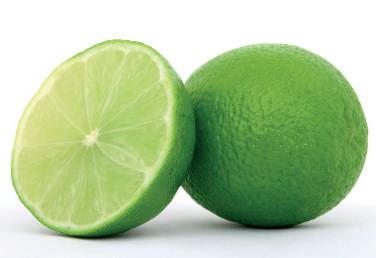

 ByEricLeClere
ByEricLeClere
Eric, a chef de cuisine of 20 years. Originally from Florida he is now based in the Limousin & caterers all of France

www.chefericleclere.com Instagram.com/chef_eric_leclere
There are preferred tacos seasonings to match certain tacos which are determined by the mix you have chosen. Since tacos are so wonderfully flexible you can use any seasoning on any protein. Homemade taco seasoning over shopbrought packets gives you control on the ingredients and taste!
INGREDIENTS
(for spices always season to your personal taste)
2 tbsp. chilli powder
1 ½ paprika
2 tsp cumin
½ tsp onion powder
½ tsp garlic powder
¼ tsp cayenne
2 tsp salt
½ tsp black pepper
¼ tsp oregano
METHOD
1. Mix well. Store in a glass jar.

The brunoise cut is the finest dice, originating from the julienne. The small, consistent pieces of vegetables release flavour evenly into dishes, enhancing the overall taste. They also provide a pleasant texture, adding a delicate crunch or softness depending on the cooking method.
METHOD - Shallots
Slice each shallot lengthwise and remove outer skin. Place shallot halves on cutting board and make a cut horizontally from the newly trimmed top almost to the stem, but not through it. Rotate the still ‘intact’ shallots and make consistent cuts lengthwise avoiding the stem. Rotate once more and finish the process by cutting towards the stem against the grain.

Best practice is to choose nice and ripe the day you plan to make. The skin should give a little if you apply pressure between thumb and forefinger, check a few spots to be certain. If it feels mushy underneath it is too ripe - if you have any doubts trust them. If there are none ready to go, choose nice ones with the nib of the stem intact if possible. Store these in a rolled/folded closed brown paper bag in a dark humid place. Check them periodically with thumb and forefinger, use when ready.
Guacamole usually does not last long. If you need to save any for later no problem. Using a rubber spatula push the guacamole into plastic/glass sealable container, trying to avoid air pockets. Using either cling film or damp paper towel cover the guacamole completely and firmly push maximising coverage. Before putting the lid on, tap it on the counter a few times, rotating once or twiceyou’re trying to knock out any leftover air pockets.
This recipe takes a little effort with a knife, but the result is well worth the time. Pico requires few ingredients so they need to be as fresh as possible for best results. I prefer shallots to red onions in this recipe, but feel free to change it up. The portion size given is sufficient as a filling with enough left to serve with some crispy tortilla chips. Making this the night before and letting it marinate in the refrigerator will give the flavours more depth and body.
INGREDIENTS (Serves 4-6)
6-8 medium vine ripe tomatoes
3-4 medium shallots
2-3 jalapeno peppers
1 bunch fresh coriander
2 limes
Sea salt
Fresh medium grind black pepper
METHOD
1. Place each tomato on cutting board stem side up and quarter, cutting from stem down to board, lay each quarter skin side down and carefully cut the seeds from the bottom to the top removing the stem as you finish. (I usually remove the stem piece and use the seeds and juice to fortify the protein being used for our tacos.) With the quarters still skin side down on your board, slice them lengthwise into small strips (this is a julienne cut). Working preferably by each quarter, rotate each and cut into consistent squares (a brunoise cut). Place processed tomatoes into large glass bowl.
2. Cut just the tops from the shallots, clean the stem side, and discard stem and debris. Slice each shallot lengthwise and remove outer skin. Place shallot halves on your cutting board and make a cut horizontally from the newly trimmed top almost to the stem, but not through it. Rotate the still ‘intact’ shallots and make

consistent cuts lengthwise avoiding the stem. Rotate once more and finish the process by cutting towards the stem against the grain. These brunoise shallots are ready to go in with the tomatoes.
3. Cut stems from peppers and discard, cut each again in half, lengthwise. Working with the skin side down, remove the seeds and ribs from each and discard, cut each half into strips lengthwise (julienne), rotate again and cut consistently against the grain (brunoise). These are now ready to join the crowd.





4. You can use all of the coriander so chop it all nice and fine and add to the bowl as well.
5. Zest both of your limes over your cutting board and add to bowl, then juice both limes and add to the mix.
6. Using a rubber spatula fold the mix into itself until well incorporated, salt and pepper to season and enjoy or refrigerate.
*If storing overnight, make sure to do so in plastic or glass not metal*


This delicious cake gets its name from the three types of milk used to make it: evaporated milk, condensed milk, and heavy cream. This authentic Tres Leches cake recipe is decadent and incredibly popular all over Latin America. It is easy to make and can be customised with different toppings and flavours to suit your preferences.
INGREDIENTS (serves 12)
Cake:
125 g all-purpose flour
1 ½ tsp baking powder
¼ tsp salt
5 large eggs
200 g granulated sugar divided
80 ml whole milk
1 tsp vanilla extract
Three milks:
350 ml evaporated milk
(lait concentré non sucré, demi-écrémé)
415 ml sweetened condensed milk
(lait concentré sucré)
60 ml whole milk
Whipped Topping:
470 ml heavy whipping cream
3 tbsp. powdered sugar
½ tsp. vanilla extract
Garnishes:
Ground cinnamon and/or fresh strawberries
METHOD
Cake:
1. Preheat the oven to 175 °C and lightly spray a rectangular pan with nonstick cooking spray.
2. Combine the flour, baking powder, and salt in a large mixing bowl.
3. Using two separate bowls, separate the eggs. Place the egg whites in one
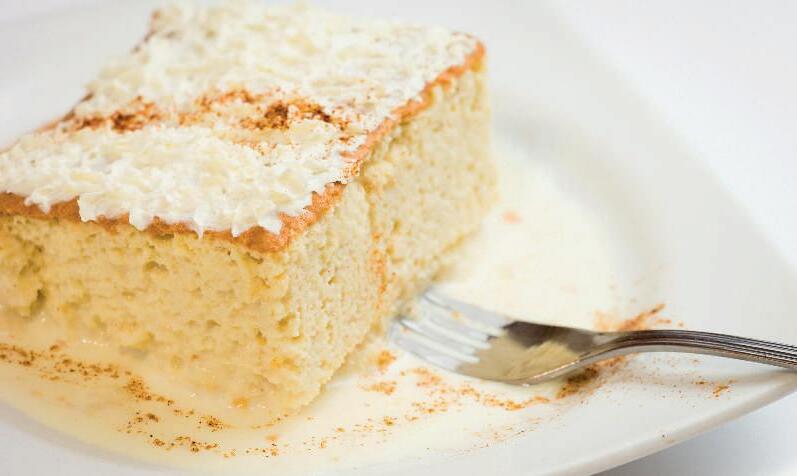
bowl and the egg yolks into the other bowl.
4. Add 175 g of sugar to the bowl with the egg yolks and with an electric hand mixer, beat on high speed until yolks are pale yellow. Add the 80 ml whole milk and the vanilla and stir to combine.
5. Pour the egg yolk mixture over the flour mixture and stir gently just until combined.
6. With an electric hand mixer or in the bowl of a stand mixer with the whisk attachment, beat the egg whites on high speed until soft peaks form (about 1 minute). With the mixer on medium-low, pour in remaining 25 g sugar and then beat on high speed until egg whites are stiff but not dry.
7. Gently fold the egg whites into the batter, just until combined. Pour batter into prepared pan and spread the batter with a spatula to even out the surface.
8. Bake for 25 to 35 minutes, or until a toothpick inserted in the centre of the cake comes out clean. Remove from the oven and allow the cake to cool completely.
Three Milks:
9. In a large measuring cup or a pitcher combine the evaporated milk,

sweetened condensed milk, and whole milk.
10. Once the cake has cooled, use a fork to poke holes all over the top of the cake.
11. Slowly pour the milk mixture over the top of the cake, making sure to pour the milk mixture near the edges and all around.
12. Place the cake in the refrigerator and chill for at least 1 hour or overnight, to allow the milk to soak in.
Whipped Topping:
13. In the meantime, whip the heavy cream, sugar, and vanilla until stiff peaks form.
14. Spread the whipped topping evenly over the top of the cake. Garnish with ground cinnamon and fresh strawberries, if desired.
TIPS…
Mix Gently: It’s very important to fold the egg whites into the batter gently to prevent the whipped egg whites from deflating completely. The air in the whipped egg whites lifts the cake while it bakes in the way other leavenings do.
Be patient: Allow the cake to soak up the milk mixture for at least two hours before serving. I know waiting to eat it is the hardest part of this recipe!













For English-speaking entrepreneurs looking to set up a micro-enterprise in France, leveraging the resources available on the National Institute of Industrial Property (INPI) website is key to a successful business registration process. Here's a practical guide on how to establish your micro-enterprise using the INPI website effectively.
Before diving into business registration, ensure you have the necessary legal permissions to work in France. Depending on your nationality and circumstances, this may involve obtaining a visa or a carte de séjour (residence permit) that allows you to engage in entrepreneurial activities.
Understanding Micro-Enterprises in France
A micro-entreprise is an ideal business structure for entrepreneurs with modest revenue expectations. This structure offers simplified administrative requirements and favourable tax conditions, making it attractive for small-scale businesses. To qualify as a micro-enterprise in France:
▪ Your anticipated annual revenue must not exceed specific thresholds (e.g., €77,700 for service activities and liberal professions or €188,700 for trade and sales activities in 2024).
▪ You operate independently or with minimal staff.
▪ Your business activities do not fall into restricted sectors.
Before diving into registration, start by refining your business concept. Define your products or services, target market, and unique value proposition. Conduct market research to understand your industry landscape and potential competitors.
Create an INPI Account:
Visit the INPI website and create a user account. This account will be used to manage your business registration process.
Verify Name Availability:
Use the INPI database to confirm that your chosen business name is available for registration.
Complete the Registration Form: Fill out the online registration form provided by INPI. Provide accurate information about your business activities, address, and other required details.
 ANGLO FRENCH HELP contact@anglofrenchhelp.com
ANGLO FRENCH HELP contact@anglofrenchhelp.com
Submit Required Documents:
Prepare and upload necessary documents. These may vary depending on your business such as:
• Proof of identity (passport or ID)
• Visa or carte de séjour
• Proof of address in France
After you submit your application, it will be automatically forwarded to the relevant authorities responsible for reviewing it. They may request additional documents or information during this process. Once your application is approved, you will receive your SIRET number.
Once you have obtained your Siret number, you will begin to receive various letters by mail. It's important to be vigilant, as some of these letters may be scams or contain false information requesting payments. Always verify with a professional whether such requests are legitimate before making any payments.
Additionally, you will receive correspondence from the tax office and Assurance Maladie. Remember to keep these documents safe. Once you receive your social security number from CPAM, you can proceed to create your account on the URSSAF website (typically after waiting 15 days from receiving the letter). This will allow you to report your earnings and pay your social contributions.
If you have any questions about this process, please don't hesitate to reach out.



Sue Cook EI
Regional Coordinator Centre Ouest 87600 Rochechouart
+33 (0)555 036 669 +33 (0)689 992 889 E: sue.c@currenciesdirect.com www.currenciesdirect.com/france



Karen and her team of associates are here to



deVere France S.a.r.l. are regulated by ANACOFI-CIF and ORIAS which will only recommend French regulated products.

Helen Booth works as a financial adviser for deVere France S.a.r.l and has lived as well as owned property in the Deux-Sèvres region. Having worked in the financial services in the UK for over 15 years, Helen prides herself in being fully diploma-qualified for the services that she provides. Helen has lived and worked in France for over 8 years and enjoys being part of deVere France S.a.r.l., a division of one of the world’s leading independent financial consultancies, deVere Group.
With over $10 billion of funds under its advice and administration and with more than 80,000 clients around the world, deVere Group truly offers a myriad of unique products and notes that are not available anywhere else in the market.

deVere France can advise you on ways to help safeguard and increase your wealth, as well as helping with HMRC-recognised pension transfers to a Qualified Recognised Overseas Pensions scheme (QROPS) to give you potentially more flexibility in your pension plans.
If you would like to know more about how deVere France can help you, contact
Helen Booth DipPFS , EFA : +33 (0) 77 171 2879 : helen.booth@devere-france.fr
et L 512-6 et 512-7 du Code des Assurances. Registered name: deVere France S.a.r.l, registered company number RCS B 528949837, 29 Rue Taitbout, 75009, Paris, France. Gérant: Mr. Jason Trowles. Registered with ANACOFI-CIF (National Association of Financial
brokers, Category B, registered with the Organisation for the Registration of Assurance Intermediaries (ORIAS). Registered number
conforms to article L 541-3 of the Monetary and Fiscal Code and L 512-6 and 512-7 of the Assurance Code. 6XKWSX •V1.1/230418

Have you thought about what would happen to your family if you couldn’t provide for them anymore? Would they be financially secure or have to rely on the charity of others? Don’t leave that answer to others. Control the situation. Have stress-free peace of mind now and focus on spending time with your family.
One of the biggest worries that keeps us awake at night is ensuring our family is financially secure. Life cover will contribute to solving that problem when you are no longer around.
What is Life Cover?
illness. Premiums are usually higher for whole-of-life insurance.
Types of Life Cover
Life cover could be:
1. Whole of life means that it covers the client until death and pays out a specified lump sum.
The lump sum payment can cover the loss of income for your family
Life cover protects your family from financial worries. It provides them with financial security and helps pay debt, tuition, living, medical, and final expenses. It is usually tax-free and paid immediately on death. It is an insurance product that pays a specified lump sum in the case of death, disability or critical
2. Term life cover is over a specific period, like for a mortgage or loan, or covers the working years of a person to replace lost income for a beneficiary or spouse.
3. Other kinds also include group life, accidental death or permanent disability.
Why buy Life Insurance?
Manages risk. Insurance is one of the best ways to manage life risk and ensure the financial security of family and loved ones.

INDEPENDENT FINANCIAL ADVISER deVere France HELEN
Guaranteed protection. Whole life cover offers a guaranteed amount at death that beneficiaries can plan their financial affairs around.
Income replacement. The lump sum payment can cover the loss of income for your family when you are no longer around.
Mortgage and healthcare costs covered. Life insurance could cover your mortgage or medical and healthcare costs if you become disabled.
Childcare. Will your spouse be able to look after your children when you pass on? What happens if both you and your spouse or partner die unexpectedly? Life cover can provide for the care of your children when you can’t anymore.
Tuition. Knowing that your children’s education will be taken care of in the event of your demise will give you peace of mind.
Preserve family business. The lump sum payout could provide a necessary boost to keep the family business afloat. The family business might be the primary source of income supporting your family.
Eliminate household debt. Debt and loans are a reality in today’s high-cost-of-living world. A life cover payout could reduce debt and relieve financial pressures for your family.
Tax-free benefit. Life cover lump sums are generally paid without tax. This means the total insured amount will be made available to your beneficiaries.
The younger you are, the cheaper your life cover is. Don’t wait till you are older; you might have to reduce the life coverage because premiums are too high.
Your financial advisor can assist with finding the right life cover to protect your family and loved ones and leave them financially secure and stress-free. Chat with your advisor today.
Please note, the above is for educational purposes only and does not constitute advice. You should always contact your advisor for a personal consultation.
* No liability can be accepted for any actions taken, or refrained from being taken, as a result of reading the above.


Yes, it is that time of the year again when you have to fill in your income tax form. It’s all in French and there are lots of pages and boxes to fill in!
Well, worry not, help is at hand. I will try to explain it to you and make it simple. I will only cover the most common revenues so for more technical information, contact me directly.
Changes
I did not notice any, so good news!
Important Dates:
You have to declare your revenue for the year 2023 (1st January to 31st December). However, the tax office accepts that you use the revenue corresponding to the UK tax year.
You can start filling the forms in online (only if it is not the first time) from now and until 25th May 2024 for Departments 1 to 19 (Charente is 16), 1st June 2024 for Departments 20 to 49, and 8th June 2024
for Departments 50 and above (DeuxSèvres is 79 and Vienne 86).
Deadline to send or deposit your paper tax form is 20th May 2024. 5% penalties if you are late.
The result (the bill!) is called ‘Avis d’ imposition’ and it is sent to you from mid-August.
forms. But there are different versions of the 2042:
The 2042 is the blue form that everybody has to fill in
Note that in September 2024, the French government will then readjust the amount that they take out of your current account monthly according to what you have filled in (so more or less or even reimburse you if you had less income than 2022). Or change the % tax on your salary if you are an employee.
What Forms and How Do You Fill Them in:
The 2042 is the blue form that everybody has to fill in and it is on this form that you report what you have filled in on other
2042: This is the normal blue 2042 form that everyone has to fill in - no exceptions. Check or fill in the information on page 1 (name, address, etc). On page 2, check or fill in the information asked for (marital status, etc) and make sure it is correct as they can give you allowances or discounts (invalidity, number of children living with you, etc).
2042RICI: This is the form on which you report things that give you tax credits such as having kids at collège, lycée, etc. The box for employing a gardener or cleaner, giving to charity is on the normal 2042.
2042C: This is the form to have if you are under the French health system via an S1 (you are receiving a state pension). You need to tick box 8SH (declarant 1) and/or 8SI (declarant 2) to avoid paying social
charges on your interest. You can also find box 8VL which is the 17.7% tax credit on your dividends. Those boxes are on the last page of form 2042-C.
2042C Pro: If you are self-employed in France, this is where you fill in your professional revenue.
This is also the form used to declare revenues from gîtes or chambre d’hôtes non-professional.
2044: This is the form to fill in if your gross rental income is superior to EUR 15 000 per year.
2047: This is the purple form (or pink) on which you enter your revenue from abroad. It is better if you start with this one and then report the result on the other forms. Here is how to do it:
2047: Enter all your pension revenues (even those from the civil service that are taxed in the UK) on page 1, section 1 in the box called “Pensions, retraites, rentes”. Be careful, you now must tick the box stating if the pension is public (ex-civil servant) or privé (private and state pension/old age). So, if you have both, tick both boxes. You then have to report pensions to the pension section on the 2042, page 3, section 1, line 1AM (or 1BM for declarant 2) for pensions taxed in France (state pension and private pensions) and line 1AL (or 1BL for declarant 2) for pensions from UK government employees such as teaching, civil service, military, NHS, etc).
Note that if you only have private pensions (not a public service pension or a state pension), you also have to pay social charges on them and have to enter the amount on section 9.
You also need to tick box 2OP on form 2042, page 3 if you want the interest to be taxed according to the rest of your income and not at 12.8% flat tax.
In section 4, you enter the revenues from house rental abroad. Then report on section 6 to get the tax credit (because it is taxed in the UK) and report on line4BE and 4BK, section 4 of the 2042. If revenues from gross rental are > EUR 15 000, you have to fill in the 2044 form and report the figures on line 4BA and 4BL on form 2042.
In section 6, you put the revenue from government employees' pensions (military, police, NHS, civil service, etc) and rental income from property in the UK (those will always be taxed in the UK whether you are a French resident or not). Then you report the amount in line 8TK, last page of the 2042. This is because those revenues/incomes get a tax credit in France equivalent to what the tax would be on it in France as they are taxed in the UK. You must enter the gross amount (before tax for pensions or expenses for rental).
3916: If you have a bank account outside France then you have to declare it on that form (sections 1 and 4). One form per account. Failing to declare them brings a fine of EUR 1 500 per account not declared. EUR 10K if the account is in Jersey, Panama or other countries which the French tax office does not like!
If you have a bank account outside France then you have to declare it
You will also need to tick box 8UU on the last page of the 2042 stating you have a bank account outside of France or 8TT if you have an Assurance Vie investment account.

A complete guide on how to fill in your tax form online is on our website:
www.bh-assurances.fr/taxes
If you are one of my customers, you are entitled to free help in 2 of our offices (no appointments, just turn up):
Chasseneuil sur Bonnieure on Wednesday 15th May (all day apart from 12-2pm, my lunch)
Ruffec on Tuesday 14th & Thursday 16th May (all day apart from 12-2pm, my lunch)
Please refer to my article ‘Social Charges on Private Pensions outside of France’ which you can find on our website www.bh-assurances.fr/taxes/ as it is just too complicated to explain here.
In section 2, on page 2 is where you put the interest you earned on savings in the UK. And yes, ISAs and Premium bonds are taxable in France as you are a French resident! So, you have to fill them in at the bottom of page 2 in the box 230 “intérêts”. Enter the country of origin, then you write the amount on line 2TR, line 252.
Then you report the amount in line 2TR, page 3, section 2 of the 2042.
22 rue Jean Jaures. 16700 Ruffec Tél:+33 (0)5 45 31 01 61
Don’t forget to date and sign the forms! If it is your first, include a RIB and a copy of your passport.
The exchange rate for 2023 is 1.15 (that is the average of last year). You can get another rate from your local tax office - use theirs if it is lower than 1.15! Note that when you ask the official Paris tax office they tell you to use the rate from the “banque de France” on the day you got paid! Or use the average of the year. If your pension has been directly transferred to your French bank account, just add up all the figures of last year as long as it is a gross amount (not taxed at source).
10 Bd du 8 mai 1945 16110 La Rochefoucauld Tél:+33 (0)5 45 63 54 31 102 Avenue de
Please make sure you have all the figures ready and the relevant forms (you can get them from your local tax office or online) when you come to see me. Otherwise I get very grumpy!
And remember to check out our website www.bhassurances.fr/en for all my previous articles and register to receive our monthly newsletter.




MARKETING4TRADESMEN
In the world of self-employment, especially for tradespeople, credibility isn't just a badge of honour, it's your most valuable asset. Unlike a traditional storefront or flashy advertising campaign, your reputation is built on a solid foundation of trust. Every satisfied client, glowing review, and successful project adds weight to your credibility, making it the currency that drives your business forward.
When a potential customer searches for a tradesperson, they're not just looking for someone who can get the job done, they're seeking assurance that they can rely on you to deliver quality workmanship, achieve deadlines, and communicate effectively throughout the project. Your credibility sets you apart from competitors vying for their attention.
information is abundant, your credibility can make or break your business.
In the digital age, where information is abundant, your credibility can make or break your business
"Credibility is a leader's currency. With it, he or she is solvent; without it, he or she is bankrupt." - John
C. MaxwellConsider this: when faced with a choice between two equally skilled tradespeople, who do you think the client will choose? The one with a trail of positive reviews, testimonials, and a reputation for reliability, or the one with little to no online presence and an unknown track record? In the digital age, where
But credibility isn't just about what others say about you, it's also about how you present yourself to the world. Your online presence, starting with your website, serves as the digital storefront of your business. A professional and user-friendly website reflects positively on your brand and instils confidence in potential clients. It should be visually appealing, easy to navigate, and provide essential information about your services, past projects, and contact details. Consistency in branding across all platforms, including your website, social media profiles, and promotional materials, reinforces your identity and builds brand recognition. This consistency creates a cohesive and trustworthy image that resonates with clients and sets you apart from competitors.
So, how can you ensure that your credibility remains strong in the eyes of your clients? It starts with a commitment to excellence in everything you do. Delivering exceptional service on the job goes beyond technical proficiency, it encompasses professionalism, reliability, and attention to detail. Arriving on time, respecting clients' property, and
maintaining a clean work environment all contribute to a positive client experience. Seeking client feedback at various project stages demonstrates your willingness to listen and adapt to their needs. This feedback loop helps improve your processes and strengthens client relationships by showing that you value their input. Going above and beyond to exceed customer expectations leaves a lasting impression and fosters loyalty. Whether providing personalised recommendations, offering additional services, or following up after project completion, demonstrating your dedication to quality and customer satisfaction solidifies your credibility and sets the stage for long-term success.
But it doesn't end there. To truly harness the power of your credibility, you must also leverage the voices of your satisfied clients. Encourage them to share their experiences through testimonials, reviews, and word-of-mouth referrals. These authentic endorsements serve as social proof of your reliability, professionalism, and expertise, further solidifying your reputation in the minds of potential customers.
In a competitive market, credibility is the foundation of trust, and your credibility is your most valuable currency. Nurture it and protect it. Because in the end it's not just about winning jobs, it's about earning the trust and confidence of your clients.

WORKING IN NUTRIGENOMICS, THE SCIENCE OF HOW WE PROFILE OUR GENOME TO WORK OUT WHAT DIET AND LIFESTYLE WORK BEST FOR THAT INDIVIDUAL, REVEALS MANY FASCINATING THINGS
Firstly, we are all slightly different, we are all unique, a combination of genes and environment. With environment being the company we keep, it’s so important to choose your friends carefully and treasure those really true friends when they reveal themselves, they are rare and worth investing in. Environment is literally the geographical location we live in; living at altitude for example has a very different effect on your body than living at sea level. Living surrounded by farmland will expose you to more pesticides than living in the city, where
Your genes make up less than 20% of the picture but your environment will switch those genes on and off
you will be exposed to more EMFs (electromagnetic fields) from Wi-Fi and 5G, and PAH (polycyclic aromatic hydrocarbons) which are carcinogenic byproducts of car exhaust fumes. The environment is also YOU, your gut bacteria (which outnumber your human cells 10 to 1), the food you eat. Do you eat packaged, processed food made in a factory or do you eat homegrown muddy vegetables and eggs from your own chickens? This is all your environment. Your genes make up less than 20% of the picture but your environment will switch those genes on and off, meaning that the whole picture is

Amanda is a registered Naturopath and Nutritional Therapist, specialising in Nutrigenomics, the science of how your DNA is affected by your lifestyle and diet. She works with clients around the world from her Private Online Clinical Practice. www.amandakingnd.com Email:nutrition@amandakingnd.com
what we need to look at, not to reduce health to one or another aspect.
Take our personality for example. We might think that we are totally unique however there are many predictable aspects of character that are revealed in certain combinations of genes. I can often tell by talking with someone what mutations they have on their genes these days, especially with respect to personality. When we think about the neurotransmitters that shape motivation, excitement or relaxation then these are serotonin (for feeling good and also appetite), dopamine (for motivation and attention), adrenaline (action) and melatonin (for sleep).


jillm@rootscounselling.fr www.rootscounselling.fr











Of course, each aspect of behaviour created by neurotransmitters needs to be relevant. If you have just done a big workout in the gym then you will want to feel a rush of dopamine, your reward. That might just keep you coming back for more. When you do something kind, you may feel a rush of serotonin and maybe adrenaline for your pleasure centres and of course when night falls that serotonin gets turned into melatonin so that you can fall asleep effectively and hopefully stay asleep all night long.
Where things go wrong, when our neurotransmitters aren’t working effectively or at appropriate times, then we start to behave in ways that can come out as symptoms. These can be anxiety, depression, low mood, difficulty relaxing, feeling just flat without really any spirit, a lack of motivation, jitteriness, frequent waking at night, lethargy or fatigue, and even brain fog, difficulty concentrating or memory issues.
The reason these things don’t work is down to a little something called methylation. Methylation is a process in the body that allows the right genes to switch on and switch off at the right time. Without it you have biological chaos. Simply put, methylation is the process of adding a carbon atom with three hydrogen atoms attached to it (CH3) to genes, enzymes or molecules to allow them to work properly. You need to have the right
environment for methylation to work properly.
While you may not be able to move geographical location immediately you can certainly eat the right foods and make sure that you move and exercise properly.
The right foods for methylation include:
▪ LEAFY GREENS
2 handfuls of leafy greens every day
▪ EGGS
At least one egg a day
▪ MEAT
Good quality animal protein, every day. Yes, I believe the human body needs animal protein to be healthy and this is because of the range of B vitamins, essential amino acids, choline, and good quality saturated fats in the meat
▪ FATS
▪ VEGETABLES
A range of different vegetables and herbs every day for antioxidants
▪ AVOID
And of course avoiding processed foods, seed oils/vegetable oils
▪ ORGANIC
Eat organic and local wherever possible
You can certainly eat the right foods and make sure that you move and exercise properly
If you follow this set of recommendations, you will give your body the range of materials it needs to express great health and that will allow your body to create neurotransmitters for your ‘personality’ in appropriate ways and also allow you to detoxify them when they have done their job. You may even find after doing this for 12 weeks that you feel better, happier, you have vitality, and your quality of life improves.
Healthy fats like olive oil (not from a plastic bottle), organic butter, and coconut oil
▪ TEA
Ideally a cup of organic green tea every day
▪ WATER
Clean filtered drinking water
▪ NITRATE
Nitrate-containing foods like beetroot or spinach
If you would like to find out which diet and lifestyle are right for you to alleviate any symptoms you experience or to improve your health then you can book in for a consultation with me for personalised nutrition through my website at www.amandakingnd.com


I so often hear clients say how they feel guilty about things they have done. Sometimes these acts happened ages ago as well as more recently. Clients also feel guilty about things they haven’t done and wish that they had. At other times guilt can be about not fulfilling a one-off or ongoing commitment. It can be just a shiver that quickly passes, but guilt can also weigh very heavy, really eat at you, and it can be persistent and allencompassing. Some people can shrug it off fairly easily whereas others struggle to not feel it constantly.
Guilt is just one of the big array of emotions we experience daily. This horrible feeling can catch us completely off guard when we remember something or say something hurtful without thinking about it.
If every one of these emotions is designed to keep us alive or safe in one way or another, what are we supposed to do with this one?
What does it tell us?
say the number of psychopaths in our society is very, very low.
What many people struggle with is that sneaky historical guilt. The one that follows them around for sometimes very long periods of time. This kind of guilt is exhausting, taking up so much headspace, sometimes to paralysis. It can keep them away from friends or loved ones, hold them back from moving on and being content.
So how do we get rid of this?
When we feel guilty, about anything really (and remember guilt is designed to teach us the difference between right and wrong) we can ask ourselves the obvious question: what did I do wrong?
What many people struggle with is that sneaky historical guilt
Guilt is designed to teach us the difference between right and wrong. When I was naughty as a kid, my mother told me off and put me on the naughty step - it was a chair behind the door in the kitchen at my house. I did not refrain from the same naughty behaviour later on because of the time spent on that chair, and the punishment as such. It was because I didn’t want to feel that horrible feeling in my stomach and chest again. I didn’t want to feel guilty again as I did when my mother told me off or when I was reflecting on what I had done sitting behind the kitchen door. I would empathise with the sibling I may have hurt and I would feel their pain or sadness. Feeling guilty told me that this behaviour was not to be repeated and it was wrong.
So guilt has a very practical purpose. And right and wrong are different depending on our cultural, religious or moral context, but the emotion in itself is universal. Pretty much everyone apart from a psychopath feels guilt and we can happily
Sometimes, when we look closely at the facts, we might conclude we didn’t do anything wrong at all. We might believe we did what we did because others told us to or we didn’t give it enough thought. But if we conclude that we actually didn’t do anything wrong, then we can drop the guilt. It was misplaced and had no purpose. So a good reality check can be quite helpful.
If, on the other hand, we conclude that we did something wrong then we have three possible options.
Firstly, we can apologise for our wrongdoing to the person or group in question. If our apology is accepted, then guilt served its purpose and we can let it go. There is no longer the need for it, we owned up to the fact that we know what we did was wrong and we show remorse. We can move on.
Secondly, we can repair. If I break my neighbour’s window, and I get it replaced and paid for, then I repaired the damage. I no longer have to feel guilty, I can move on.
Sometimes it is not a practical situation, like replacing a window, but the damage is emotional. Repair can be listening to and actively understanding and acknowledging the other’s hurt and situation. We can ask them what we can do to make up for the damage, to make things better, and be
 ByRafaëlDupré
ByRafaëlDupré
Originally from Belgium, Rafaël has run private practices in the UK and France, working with individuals or couples on a huge range of issues
rafael@a-therapy.com
t. 07 83 23 77 23
Advert on page 30
humble enough to examine our own motives.
And lastly, if we can’t apologise or there is no possibility of repair, we can learn a lesson. We reflect on our actions and commit to never act in that way again. We learnt our lesson, improved our behaviour or thought patterns, and no longer need to feel guilty. We can let it go.
Now all this sounds pretty simple and straightforward, but the reality is that often it takes quite a bit of reflection and self-compassion to get to the point where we can drop guilt. It could be helpful to sit down and take the time to write your story down. Do the reality check exercise above. Ask yourself if you did something wrong and if so what exactly did you do wrong? Write down what the options are in your specific situation and gather the courage to apologise, repair or learn a valuable lesson. We all deserve to move on. More often than not, your courage and efforts will be appreciated and you will feel so much lighter for it. Ultimately, guilt can lead to personal growth. If we listen to it and work with it, then that horrible feeling can be used to make us a better person.

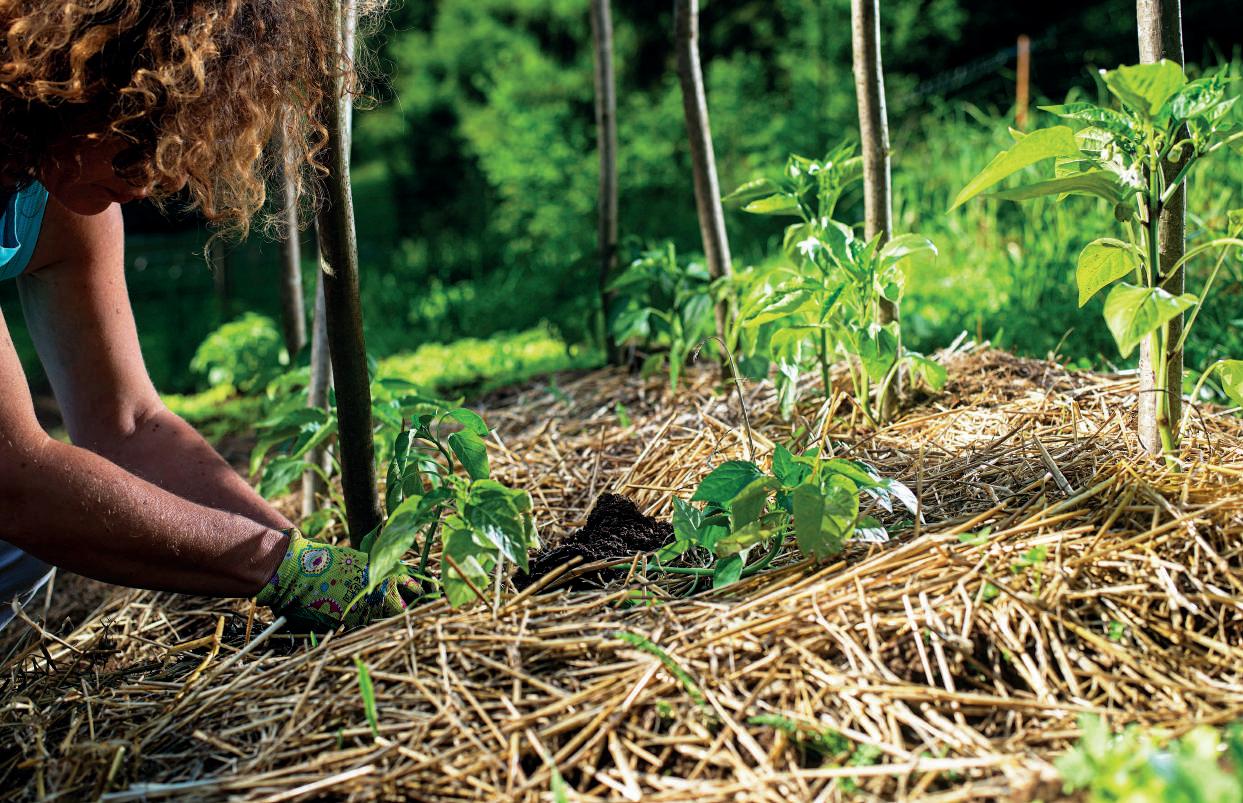
MAY IS ONE OF MY FAVOURITE MONTHS OF THE YEAR - IT STARTS TO FULFIL SOME OF THE PROMISES MADE EARLIER!
It's the time for tidying up and looking carefully at the plants returning from previous summers. Perennials spread over time, lose some of their brightness and generally look a bit unkempt, so now is the time to divide them. Lift clumps of herbaceous perennials and pull apart to separate the parts you want to remove. Put the newer, fresher parts back into the garden and find a ‘new home’ for the pieces you no longer want. It’s also worth dividing large clumps of overcrowded daffodils after they have flowered. In the vegetable garden there’s plenty to do between sowing and planting courgettes, tomatoes, pumpkins, aubergines or melons. It’s also the time to plant flowers in the vegetable garden, to attract pollinating insects and protect your vegetables from some pests in a natural way!
Irregular watering creates water stress in plants, but applying mulch limits this stress
runoff. Irregular watering creates water stress in plants, but applying mulch limits this stress, helps keep soil moist and weeds at bay. Overall, organic mulching protects, improves, and fertilises the soil. Organic mulch is recycled materials spread on the ground between crops and plants to protect them from nutrient leaching, reduce weed growth, and provide protection against excessive heat or cold. It remains loose on the surface of the soil, does not need to be turned and, over time, micro organisms will transform it into fertile humus. Ground that is mulched needs less watering as evaporation is reduced. It also protects plants from competition from weeds that can’t germinate under a thick mulch layer. This will make water and nutrients available directly to your plants and only to them!
 By Ronnie Ogier
By Ronnie Ogier
Ronnie is a passionate gardener and now loves sharing her years of experience of success and failures in her own garden and sharing it with you. Also a keen runner, having been bitten by the ‘Couch to 5K’ bug!
of rainwater and groundwater. Spread out in a thick layer, it limits the growth of wild grasses, and slugs and snails don’t like its coarse nature. However it takes a long time to decompose, and contains carbonaceous elements.
Hay is not the same as straw, it is made from mowing grasses. It is green and made up of stems thinner than straw, but beware it may contain weed seeds! It decomposes much faster than straw and contains more nitrogen. It is aerated and fertilises the soil quite quickly as it decomposes. This mulching should be renewed quite often.
Whether you are considering your vegetable garden or your ornamental garden, one lesson we should all now have learnt is that soil moisture should be constant. If we allow soil to dry out and then water there is a lot of water wasted in
Straw is a commonly used mulch. Made from cereal stems after harvest, it is light coloured and quite rigid. Very light, well ventilated, it ensures good ventilation on the ground and promotes the penetration
Dead leaves can be an excellent mulch, but choose leaves free from disease. This type of mulching reproduces the phenomenon present in forest canopies by protecting the soil and transforming it into very rich humus. If the leaves are really tough you can speed up the decomposition


process by running the lawn mower over them first.
Grass clippings are a great source of green waste for mulching. Let them dry a little before spreading them or they may form a compact layer that is quite impermeable to air and water. This type of mulch is very rich in nitrogen. In a thick layer, it has the same qualities as previous mulches.
Sawdust, if it is used, must be from untreated wood and free from glue and solvents. Sawdust is light, allows water and air to pass through, and contains carbonaceous elements. It effectively protects the soil by insulating it against heat variations, limits evaporation and the growth of weeds. It takes a while to break down, so you won't have to come back to it every month.
plants or protect the base of rose bushes (especially the grafting point).
Kitchen scraps such as vegetable peelings can be used as organic mulch. They will bring heat to the soil as they decompose as well as many nutrients. They have the disadvantage of being unsightly but can be covered with a layer of straw. It’s important to ensure there are no meat or dairy products included as these will attract vermin.
It is ideal for showcasing ornamental plants with dark or red foliage to create contrast
Compost is an excellent addition, especially in early spring, because it protects plants from nitrogen starvation, unlike other organic mulches. It fertilises the soil and loosens it. The only drawback is that it can offer a prime breeding ground for weeds!
in autumn or late spring. Avoid spreading it at the end of winter as it can cause nitrogen starvation. If you are buying this it can be available in a variety of colours to highlight certain foliage and bring originality to your garden.
Flax and hemp are a very light mulch that is porous to water and air. It is ideal for showcasing ornamental plants with dark or red foliage to create contrast. It has the same benefits as other mulches but can fly away in very windy areas.
Cocoa shells offer a durable and original mulch. A good coat will prevent weeds from growing, but it can be costly.
Fern fronds are sometimes used as a mulch as they are plentiful in autumn and provide a good cover for the soil, they are light, and allow water and air to pass through. They also have antifungal and insecticidal properties. As they decompose, they release metaldehyde that poisons the slugs. Traditionally fern fronds are used to mulch strawberry
Fresh manure should be spread in autumn as mulch so it will have time to decompose without burning the plants as would happen with a spring application. It is ideal for winter cover because it protects the soil well, boosts biological activity while being sufficiently aerated to allow air and water to pass through.
BRF (Bois Raméal Fragmenté) is made from the crushing of small branches. It is a useful mulch, it is durable, protective, and fertilises the soil. It is ideal
Pine needles and bark as they decompose will make the soil more acid, which can be good for correcting a chalky soil. Slugs and snails do not like this mulch. The bark takes longer to decompose than needles, so can be used for paths between beds.
And finally, one of my regular obsessions, if you haven’t taken photographs of your garden in previous years, try to get into the habit of doing so now. Monthly photos of your garden remind you where plants are and where there are gaps. They let you see what went well and what didn’t work, and it’s very rewarding to look back at your successes at different times of the year.




















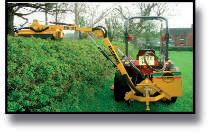



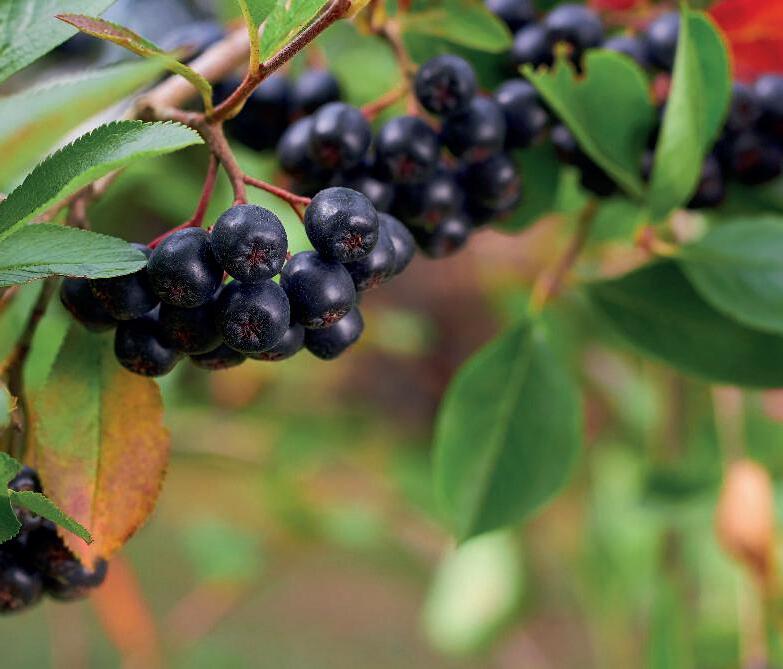
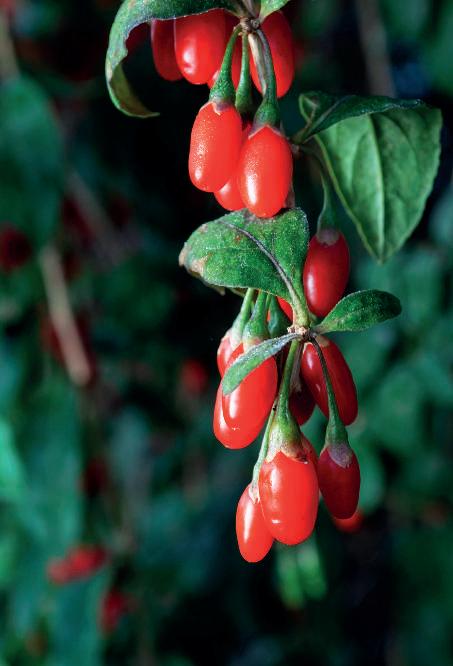
SUPERFOODS ARE NATURAL, RAW INGREDIENTS THAT ARE NATURALLY VERY HIGH IN VITAMINS, MINERALS, ANTIOXIDANTS, OMEGA 3, ETC. IN LARGE QUANTITIES COMPARED TO THEIR CALORIFIC VALUE
Many people try to include as many as possible in their diets for the associated health benefits, but many of these ingredients can be expensive to buy. There are several food groups included in the range of ‘superfoods’ that can be grown at home. Let's take a look at some that we have found easy to successfully grow in the climate here:
Berries: There are a wide range of berries that grow on shrubs that are also attractive plants to have in the garden. They don’t necessarily need to be grown in a dedicated soft fruit bed and can be mixed into your shrub or mixed borders.
My favourite of all is Amelanchier canadensis – it has many common names including the ‘juneberry’ because it produces its blueberry-like fruits in the month of June. Other common names include ‘chuckleberry’ and ‘chuckley pear’although I am unsure of the origins of
these names! As I write this article in early April my amelanchiers are in full blossom and one of the joys of spring. I am looking forward to the berries which are sweet and tasty and can be eaten raw, used in baking, and also used to flavour syrups and liqueurs. The autumn colour of the leaves is also stunning; it is an all-round winner. In its native Canada the berries are an important source of vitamin C. The only trouble is that you have to beat the blackbirds to them!
used in syrups, teas, and cooking and baking.
The fruits taste a little bit like a cross between a blueberry and a raspberry
Aronia melanocarpa. This shrub has the common name of ‘chokeberry’ because they are not so palatable for eating raw, but they are highly prized in their native Russia and eastern Europe because they are packed with vitamins, minerals, and antioxidants and are used in traditional natural medicine. They can be stewed,
Goji berries are surprisingly easy to grow. They make large arching shrubs so they need a bit of space, and plenty of sunshine, but if you have room for one they produce masses of the tiny red berries well-known for their health benefits. The small pink flowers are pretty too and are produced in abundance towards the end of the summer. The fruits can be eaten raw, cooked or dried.
Lonicera caerulea is a type of shrubby honeysuckle that produces edible fruits and is known as the ‘honeyberry’. The fruits taste a little bit like a cross between a blueberry and a raspberry and are produced in pairs along the stems from mid-May following scented flowers. These fruits are high in vitamins and antioxidants and can be eaten raw or


cooked. It is an attractive medium-sized shrub, but like most honeysuckles it needs a little bit of shade.
Other more common berries include blueberries (this one needs an acid soil), raspberries, strawberries, redcurrants, blackcurrants, gooseberries, and jostaberries (a cross between a blackcurrant and a gooseberry). I have found that they all benefit from some shade or protection from the afternoon sun as these tiny berries can literally cook on the plant if they are grown in direct sun.
Greens: Well known for their vitamin and iron content, green leafy vegetables are generally widely available to buy but they don’t stay fresh for long and the vitamins start to break down as soon as they are picked so shop bought greens will not be as vitamin-packed as those freshly picked from your garden. We have found some greens a bit tricky to grow here as the long hot summers often make them bolt (go to seed) and we find that flea beetle is very hard to control organically (this tiny beetle creates masses of holes in the leaves and is very problematic during the growing season) but we have found that winter greens such as kale, sprouting broccoli, and chard are much better because their main harvesting season is outside of the breeding season of the flea beetle. We have also found that raising the young plants in pots and planting them out a little later than usual helps to protect them from both the sun and the pests.
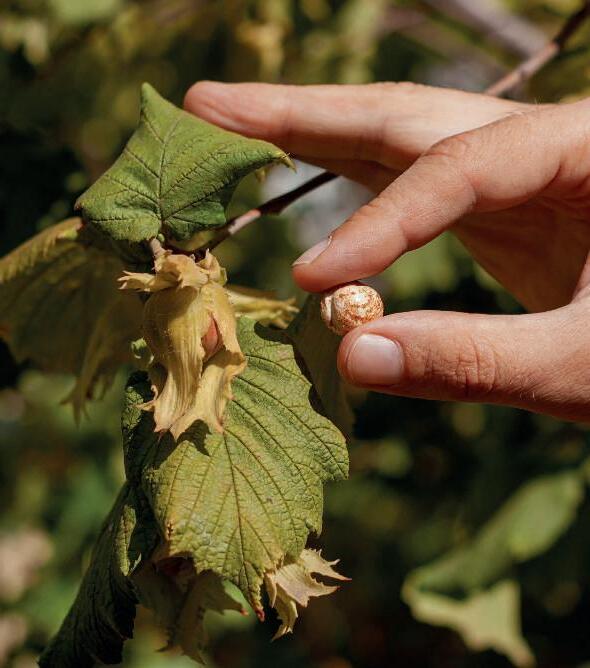

Caroline has been a lecturer in horticulture for 20 years and now runs a nursery and ‘garden craft’ courses in the Haute-Vienne at Le jardin créatif
We have also found that raising the young plants in pots and planting them out a little later than usual helps to protect them
Nuts: Here in mid France the climate is good for a whole range of nuts, particularly hazelnut and walnut. Both of these trees are wind-pollinated so we do not need to worry about the late frosts as much as insect-pollinated nuts such as almonds. I have a young almond tree but they flower so early that the beautiful blossom and/or young developing fruits have been hit by frost, or pollination has been poor due to high winds and heavy rain for the last 4 years in a row. But we generally get a good crop of hazelnuts and walnuts. Hazelnuts grow on shrubs/small trees that are very easy to care for and start producing in their third year. Walnuts are large trees and need plenty of space, although they do not need any specialist care, however you will have to wait several years for your first crop.
By planting a range of nuts, berries, and greens you can harvest and store a yearround supply of your own home-grown superfoods.


We have a range of superfood plants at our nursery at Le Jardin Créatif as well as a wide range of decorative shrubs, cottage garden perennials, herbs, and ornamental grasses. You can browse our plant list on our website and check out our courses and workshops: lejardincreatif.net
We also have a range of ‘how to’ tutorials on our YouTube channel: Le Jardin Creatif France
Caroline Wright Le jardin créatif



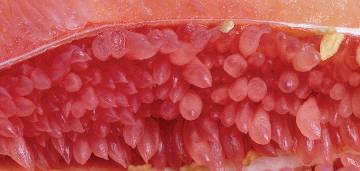

THE WINTER MONTHS SHOULD REALLY BE BEHIND US NOW AND HOPEFULLY WE WILL HAVE SOME BETTER CONDITIONS FOR OBSERVING DURING INCREASINGLY SHORTER NIGHTS
The month of May will bring us a meteor shower, a pretty conjunction, an occultation, and we can begin to look out for the return of the major summer constellations as spring - and the related spring showers - gives way to drier times. The planets are still poorly placed for observation this month although it won't be long before Mars and Jupiter in particular make their return to our skies.
Observing this month could begin with spotting the very bright and scintillating star Arcturus, which can be found high and prominent in the southern part of the sky. It is the fourth brightest star in the night sky and the lead - or 'Alpha' - star in the constellation of Bootes. Arcturus will also
Observing this month could begin with spotting the very bright and scintillating star Arcturus
point the way towards the prominent constellation of 'The Plough', which will in turn show you where the north star of Polaris can be seen. At this time of the year The Plough will seem to be standing on its end with the star Arcturus furthest south and the bottom of the 'pan' facing towards the west. You can then look for the constellation of Corona Borealis - or The Crown - which sits just to the east of the kite shape of Bootes. Moving further to the east you will be able to see the 'Keystone ' asterism which is part of the summer constellation of Herculesor The Strongman. Another observing opportunity which can continue throughout the summer months is to

Claire Wardlaw, originally from Edinburgh, lives in the Charente with her husband. Since their move to France, Claire has become passionate about astronomy
follow the fascinating constellation of Ophiuchus. This constellation is located close to Bootes, with Hercules to its north and Scorpius to its south. It is more commonly known as Serpens, or The Snake, and is home to many deep sky objects which could be found with a telescope. With the Milky Way skimming the northeast corner of Ophiuchus and the Messier objects such as M9, M10, M12, M14, M19, M62 and M107 found within this region, it is well worth spending time observing here this month.
The Moon Phases and Observing Last Quarter Phase ; 1st at around 00h30

Moon Phase ; 8th at 04h20
First Quarter Phase; 15th at 00h50 Full Moon Phase; 23rd at around 15h00. ...A second Last Quarter Phase will be visible on 30th at around 18h15
We have the chance to observe a very special event involving the Moon this month. On 24th May, and with a telescope and clear skies, we should be able to observe the Moon seemingly sliding in front of the deep sky object Messier 4. This is a large Globular Cluster listed in the Messier catalogue of 110 objects which was compiled by the French astronomer Charles Messier in the 18th Century. Depending on your precise location, the object will disappear and then reappear from behind the Moon in the south east. On the 8th of May we may be able to see a conjunction of a thin, waxing crescent Moon with the deep sky object M44, otherwise known as The Beehive Cluster. Clear skies and binoculars or a small telescope will benefit you in this search.
hourly rate of around 50 meteors, some having persistent trains. Luckily the moon will not be too bright at this time of the month as it is in a 5% waning crescent phase. Good luck with this slightly more challenging observing event!
Asteroid 2 Pallas
We have the chance to observe a very special event involving the Moon this month
This minor planet may be observed with a good telescope in May. It will reach 'Opposition' - the period in a planet's orbit when it is at its closest to the Earth - on the 17th. You will be able to observe this asteroid by first locating the 'Keystone' in Hercules which lies to the north and east from the bright star Arcturus.
Asteroid 2 Pallas will be located a little to the south and west of the 'Keystone'. Throughout the month its movement will seem to take it closer to the constellation of Corona Borealis.
Astronomy Jargon BusterOccultation

China's Chang'e-6 rocket is expected to launch in May 2024 and touch down on the Moon's far side to collect samples of lunar material to be returned to Earth for study.

The mission will make the first ever attempt at collecting material from the far side of the Moon and deliver it back to Earth for analysis. Launch is planned for around May. Chang'e6 is expected to be a 53-day-long mission. The mission lander will seek to touch down in 'Apollo basin' on the far side of the moon and collect up to 4.4 pounds of lunar materials using a scoop and a drill.



This meteor shower will peak on the evening of the 5th and your chances of observing one of these will increase the further south you are located. Waiting until the early hours of the morning on the 6th, when The Water Jar has risen and when it is still dark enough, you will be witnessing remnants of the Comet 1P/Halley as they shoot through our atmosphere. We can expect a maximum
This word has nothing at all to do with the occult, in astronomical terms! An occultation describes an observing phenomenon as seen from here on Earth. We can regularly witness, for example, the Moon occulting stars, and slightly less frequently planets. Most recently I observed and imaged the Moon occulting the planet Mars. It seemed to disappear behind the Moon and reappear some time later. This month, as detailed above, there will be an occultation of M4 by the Moon.
Happy Stargazing!

On 27th May 1933, the World’s Fair opened in Chicago, Illinois, with “Century of Progress Exposition” as its theme. The exhibition, created to celebrate scientific and industrial progress, was kicked off with a demonstration using the 40" Refracting Telescope from Yerkes Observatory in Williams Bay, Wisconsin, along with telescopes from the University of Illinois Observatory, Harvard College Observatory, and Allegheny Observatory. Through the telescopes, light from the star Arcturus was focused onto photocell tubes, devices that produce an electric current when exposed to light. Each of the four observatories sent the current to the Chicago fairgrounds through the Western Union telegraph lines, powering on the lights of the event. The idea of basking under the rays of a distant star (though somewhat indirectly) dazzled the audience so much that nearby Elgin Observatory was pressed to light the fair in similar fashion every night for the remainder of the season. This was the inspired idea of the scientist Edwin Frost who was then the director of the Yerkes Observatory.

OFTEN WHEN I WRITE ABOUT NATURE I WRITE ABOUT BUTTERFLIES, OR ADORABLE FURRY CREATURES, BUT OF COURSE THERE ARE UNCOUNTABLE NUMBERS OF LESS BEAUTIFUL AND LESS CUDDLY ANIMALS WHICH ARE EQUALLY VITAL TO THE CONTINUATION OF OUR ENJOYMENT OF THIS PLANET, AND INDEED MANY UPON WHICH OUR CONTINUED SURVIVAL DEPENDS
 ByMikeGeorge
ByMikeGeorge
Mike George is our regular contributor on wildlife and the countryside in France. He is a geologist and naturalist, living in the Jurassic area of the Charente
I thought first of worms, but of course, one cannot confine oneself to thoughts of the earthworm, Lumbricus. There are many other species of worm, and sadly, yet other species called worms which are nothing to do with worms. Unfortunately, over the centuries, the word has been universally misapplied.
So What Is a Worm?
“Worm” is derived from the Anglo-Saxon word wyrm. This referred to anything long and unidentified and serpent-like, with or without legs, and was initially used to refer to dragons. You find echoes of this in JRR Tolkien’s “Lord of the Rings” trilogy, which deals in dragons and frequently refers to them as “Worms” – don’t forget that Tolkien was a Professor of mediaeval and modern English.
However, the term began to be used for anything that was long, thin, legless, and wriggly. Sadly this not only meant the worms we know by that name today, but also reptiles, caterpillars, grubs, and a host of other creatures. A few moments’ thought will bring to mind the glow-worm (a beetle), the slow-worm (legless but a true lizard, therefore a vertebrate!), the Rook-worm (the larva of the Cockchafer Beetle, beloved food of Corvid birds), the Woodworm (a beetle larva), the Shipworm (a bivalve mollusc), the Inch-worm (the caterpillar of the Noctuid family of moths, famed for their “looping” movement), even the Silk-worm, which is also a moth caterpillar. There is an obscure phylum of invertebrates, the Onychophora, no relation to worms at all, that are called in English the Velvet Worms, and they have rudimentary legs and walk! Incidentally,
Ring-worm is not an animal at all, but a fungal infection of the skin.
Classification Problems
Of course, this confusion did not help when it came to classifying living things in the 18th century. Carl Linnaeus was the first to try, and he is usually credited as the originator of the modern system of classification of living organisms. However, when he published his Systema Naturae in 1758, he left a lot of anomalies that needed sorting out. For example, he created separate phyla for Fish, Amphibians, Reptiles, Birds, and Mammals, all of which later had to be merged and placed in the phylum Chordata, because they all have spinal cords, subphylum Vertebrata, because they all have skeletons with spinal columns!
“Vermes” were re-assigned to their appropriate phyla.
So let us have a look at the different worms as we now know them.
The Platyhelminthes
You find echoes of this in JRR Tolkien’s “Lord of the Rings” trilogy, which deals in dragons and frequently refers to them as “Worms”
These are usually feared as parasitic worms. Some are, of course; the tapeworm lies in this phylum, and is well known as a parasite, both of our domestic animals and of ourselves. Platyhelminth worms are flat-bodied, ribbon- or leafshaped, usually with a pair of eyes at the front. Generally they are colourless or white, but some flatworms can be quite colourful.
The Nematoda
But it was the worms (which he placed in a phylum named Vermes) that caused innumerable headaches for his successors. Into this had gone such a hotch-potch of long, thin creatures that Jean-Baptiste Lamarck, who began reviewing it in 1793, was moved to describe it a “A bloody mess” (une espèce de chaos).
Eventually the phylum Vermes was abolished. The true worms were divided among three phyla of their own: Platyhelminthes (flatworms, tapeworms, and flukes), Nematoda (threadworms, roundworms, and hookworms) and Annelida (segmented worms) which includes the familiar earthworm. Other
This group contains the roundworms, thread-worms, and hookworms. Many are parasites of domestic animals and humans. Fortunately, their infestations are usually simply cured by the careful application of a helminthicide, a chemical that kills them.
The Annelida
Here we are on familiar ground. The earthworm is in this group, as are the lugworms and bristle-worms of the sea. They are characterised by having their bodies divided into segments or rings.
How Big Can Worms Grow?
All one can say is, “It depends on the worm”. They are very variable in size, from the vinegar eelworm, a nematode, which is microscopic (1-2 mm long) and lives in liquid vinegar, to some worms that can measure a metre in length. Of the
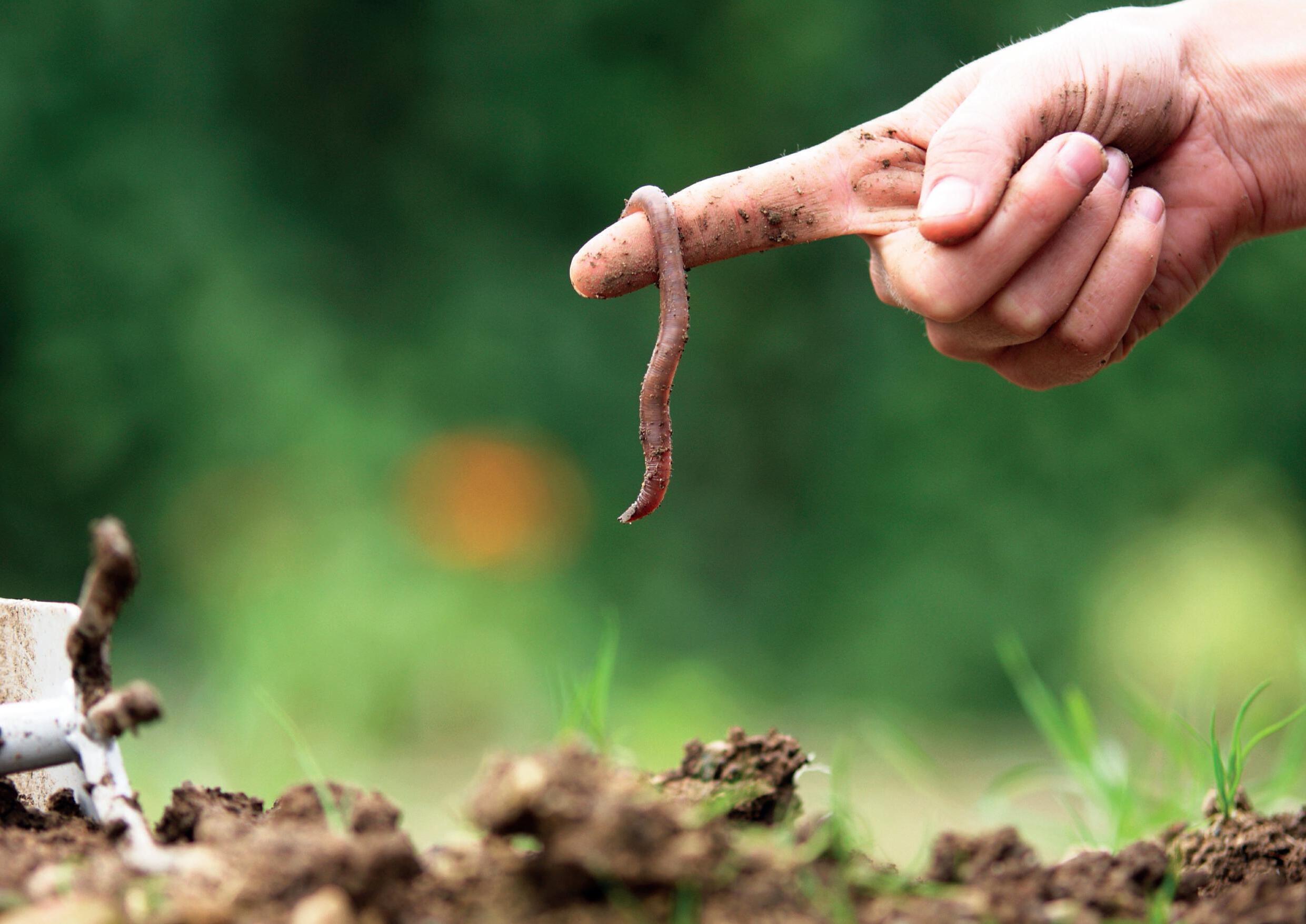

three groups above, the largest is the giant earthworm of Africa, Michrochaetus longissimus, which can reach 6.7 metres in length, and another of a similar size reportedly from Vietnam. The recordholder does not lie in any of the above groups, however; the marine Bootlace Worm, which lies in the phylum Nemertea, can reach 58 metres in length. That is longer than many houses, but of course, it lives in the sea and is supported by water. Land-dwelling worms such as earthworms are limited by their weight and tissue-strength. The female Guineaworm, a parasitic nematode that dwells in the human body, can reach 1 metre in length, as can the tapeworm.
The Earthworm
Let us look at the earthworm, as the most familiar, to gain an overview of annelid worms. Like all worms, it is a tube-withina-tube, that is, a long, thin central hollow encased in a tube of tissue. The hollow tube is the digestive tract. The mouth at the front, which is plentifully supplied with sensors, gathers the food, which is organic detritus from decayed vegetable matter, dead animals remains, faecal matter, even tiny living creatures. This passes through the worm by a peristaltic action (the act of moving is often enough) and the waste is ejected at the tail end. It is estimated that a worm will digest about one-third of its body-weight in food in one day.
Earthworms are eyeless but have sensors that can distinguish light and darkness.
They are also sensitive to vibration and to touch.
The body has a circulatory system, pumping a blood-like fluid around the body by means of a system of muscles. This blood carries nutrients, and also contains a form of haemoglobin, which absorbs oxygen that diffuses through the skin into subcutaneous capillaries, and carries this throughout the tissues. It is this haemoglobin that gives the common earthworm, Lumbricus terrestris, its brownish-red colouration.
passes over the egg-laying orifice. The ring of tissue crumples and forms a tiny cocoon, in which the eggs hatch and from which the young worms emerge. An average of 4 babies will result.
A worm has no hard skeleton, of course; its shape is maintained by a system of tubes
A worm has no hard skeleton, of course; its shape is maintained by a system of tubes kept semi-rigid by fluid pressure. Movement is facilitated by stiff spines called setae protruding from the body surface. The worm contracts and widens the rear of its body, causing the spines to engage with the material it is crawling across or burrowing through. It then narrows and extends the rest of the body, pushing aside the material ahead of it, then widens the front of the body, narrows the back part and pulls this forward.
Earthworms are hermaphrodites, that is, they carry both male and female reproductive organs. Thus, when they mate, each of the pair fertilises the other. The sperm is stored for up to 10 months, but eventually, a thickened ring of tissue forms around each worm’s body. The worm releases this and backs out of it, depositing newly-fertilised eggs into it as it
When you were young, you were almost certainly told that if you cut an earthworm in two it will grow into two complete worms. Sadly, while this is true of some nematodes and platyhelminthes, it is not true of earthworms. If an earthworm loses a few segments from its tail-end it can re-grow the lost segments, but the amputated tail dies. Some earthworms have been reported to shed their tails voluntarily to distract a predator, and certain so-called compostworms store the waste from their digestion in their tails and eventually shed these to dispose of the waste.
If an earthworm is cut higher up, both halves will die.
It is estimated that the average life-span of an earthworm in your garden is about a year, though in captivity they have been known to live for 6 years.
So be kind to your earthworms. They are a miracle of specialisation, and they are responsible for fertilising and aerating the soil of your garden, while their relatives transform your domestic organic waste into useful compost.

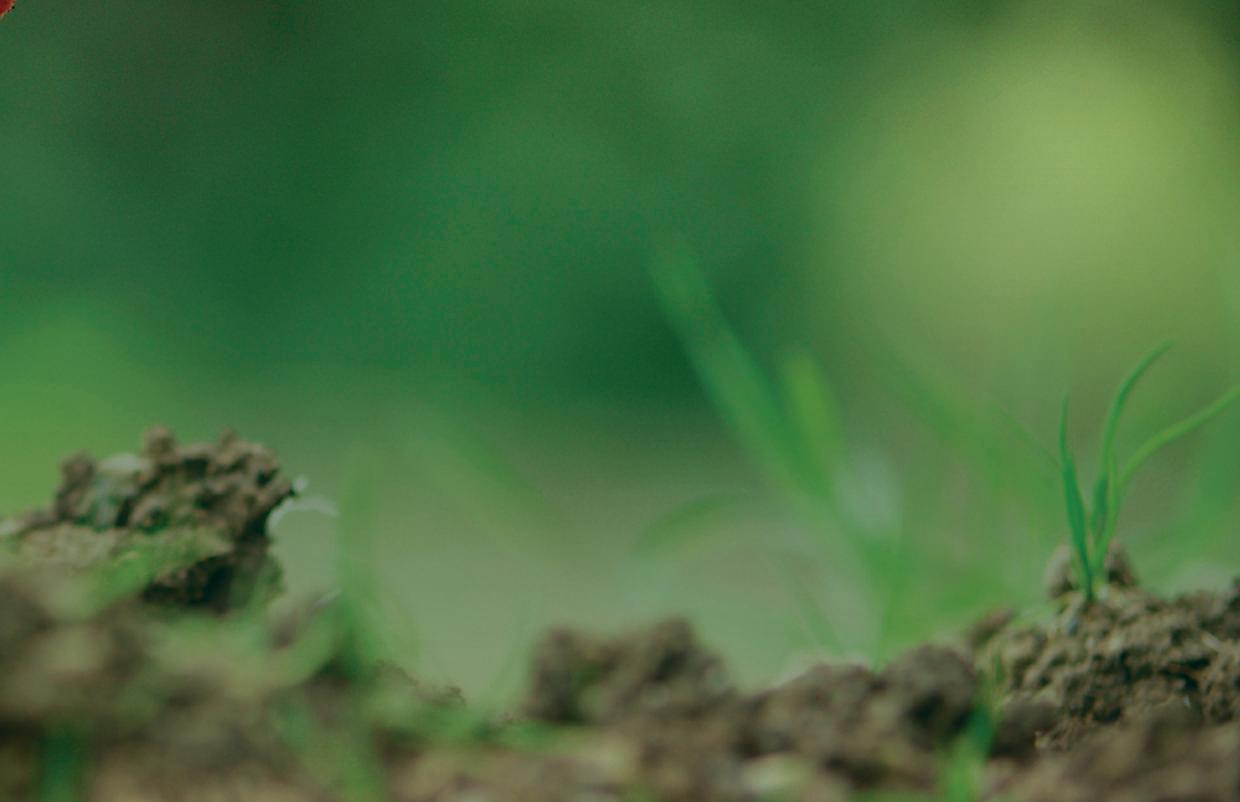
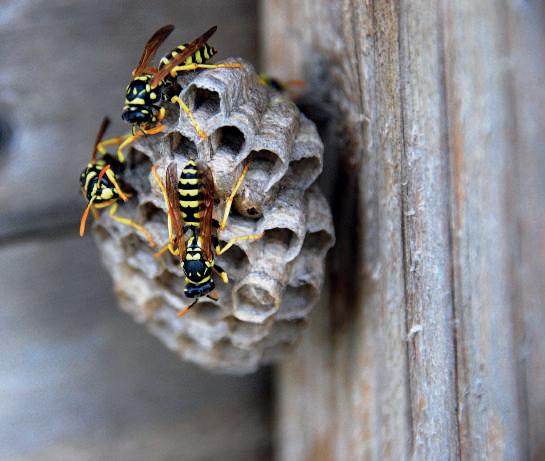
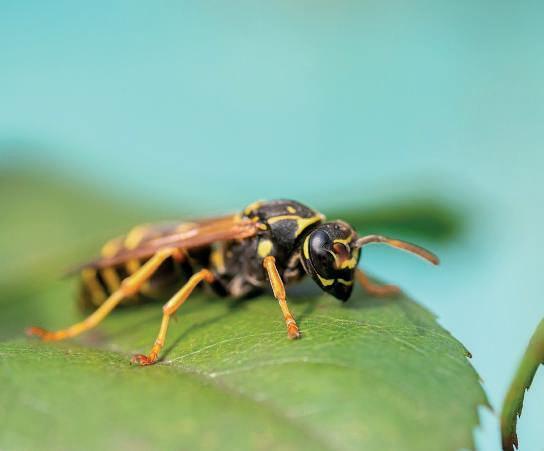

A Digging Wasp Ammophila sabulosa with prey. This will be buried in a sandy substrate to feed the wasp's developing larva.


Note


Fear of bees, technically known as melissophobia, or perhaps more realistically as apiphobia, is one of the common fears among people and is a kind of specific phobia. It is similar to fear of wasps (spheksophobia). Both are types of entomophobia (fear of insects), which is itself a category of zoophobia (fear of animals). I went and looked that up specially for you.
A casual glance at their body-shape and way of life will confirm this, but there are significant differences, not least in the way we react to them.
Both types of insects have species that are colonial, and others that are semi-colonial and even solitary. The colonial species gather together in large nests, with a hierarchy of queen, males and workers (honey-bees, common wasps, hornets). The semi-colonial live in a nest with a few tens of members who share duties (bumblebees, paper wasps). Both of these types rear their young to adulthood. The solitary species lay eggs in a chamber that is provided with suitable food for the larvae. The chamber is then sealed, and the developing insect left to fend for itself.
The chief difference in lifestyle between bees and wasps is in the food requirement of their larvae. Bee larvae can only digest pollen and nectar, while wasp larvae require protein in the form of minced-up insects. This drives the insects to their roles in horticulture. Wasps keep down many noxious and unwanted species of other insects, and without their work, the pests that eat our produce and plants would be far harder to control.
Bees are totally adapted to collecting nectar and pollen from flowers, thereby making them the most efficient pollinating agents in nature. Without bees, it is highly probable that agriculture, except for cereals which are windpollinated, would be impossible. Think about that for a minute. Sunflowers and most other oil-producing crops, fruittrees, flowering plants and along with them whole ecosystems, all would cease to exist.
Most people know this, and therefore even the most phobic of insect haters will grudgingly tolerate bees, especially bumblebees, provided they don’t nest somewhere inconvenient. So, encourage
them! Get a bit more active. Plant flowers that bees like. Borage is especially good. The bees love it, and you can spend hours watching them going about their business. And you can use the edible flowers for salad decoration, too.
Wasps, However, Are Everyone’s Enemy.
They ruin picnics and quiet tea-times. They sting without warning for no reason. It’s all deliberate and probably a conspiracy.
This is complete rubbish! Wasps have no desire to sting humans – they can’t feed us to their larvae, so why waste good venom? It takes a finite – and quite appreciable – time to replace expended venom. Wasps will only sting if threatened, or hit by a flailing hand, or sat or trodden on. Or if they feel their nest or food is threatened.
 ByMikeGeorge
ByMikeGeorge
Mike George is our regular contributor on wildlife and the countryside in France. He is a geologist and naturalist, living in the Jurassic area of the Charente
times, mainly as a result of my own carelessness. However, it is not a pastime I’d recommend. Prudent bee-keepers protect themselves very carefully before working on their hives or handling bees, and people working on wasp and hornet nests do the same. Unprotected handling of individual venomous insects, even with experience, is only for emergencies. However, I can tell you that to sit still in the middle of an active, circling swarm of bees (which is the best thing to do in that circumstance) is a nerve-racking but inspiring experience.
Wasps have no desire to sting humans –they can’t feed us to their larvae
Of course, when a bee stings, it dies, so a bee tends to use its weapon to defend the colony. A wasp can survive the delivery of a sting, but if they perceive no threat, they will withhold their venom. I have handled wasps, hornets and bees with my bare hands, and only been stung about three

Being Stung Does Hurt!
To be honest, the surest way to ensure that you or someone near to you gets stung is to jump up from your picnic, run in circles, flap wildly about with your hands and scream when you see a wasp or a bee.
Furthermore, if you kill a wasp or bee close to its nest (and the nest can be wellhidden), the dying insect will release a pheromone (a scent) that informs the colony of danger, and you are likely to have a whole lot of the deceased’s nestmates heading your way in a very bad mood.
European Hornet Vespa crabo:
Large social wasp species, up to 3.5cm long
Nest made from paper formed by chewing wood and saliva, large, usually in a tree buy may invade buildings
Not very aggressive unless colony or food source is threatened, or perceived to be so
Sting is reportedly quite painful but contains lower toxin content than other hornets (e.g; Asian hornet)
Tend to be crepuscular or nocturnal, though will hunt by day

European Wasp Vespula germanica:
A social wasp species, up to 1.5cm long
Nest made from paper formed by chewing wood and saliva, often invades buildings but uses trees also
Generally more aggressive than hornet with less provocation
Sting is moderately painful. As with a hornet sting, wash with soap and water immediately and apply ice
Generally diurnal
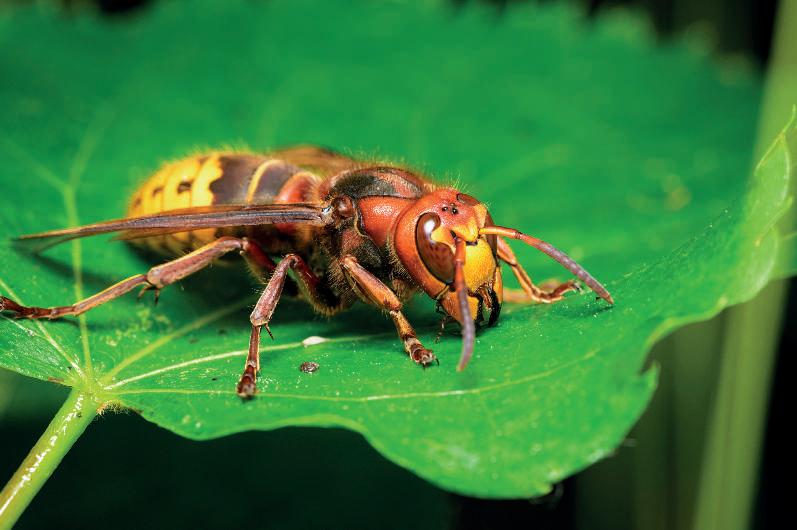

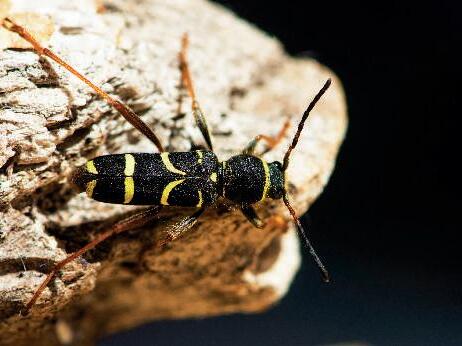
Wasp-beetle
Clytus arietis copying a wasp's colouring. Not very convincing to a human eye, but might fool a predator!
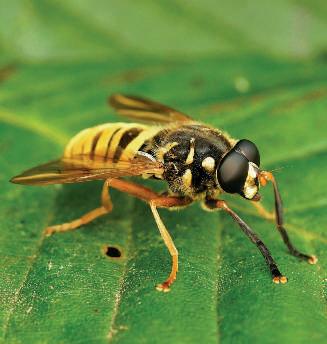
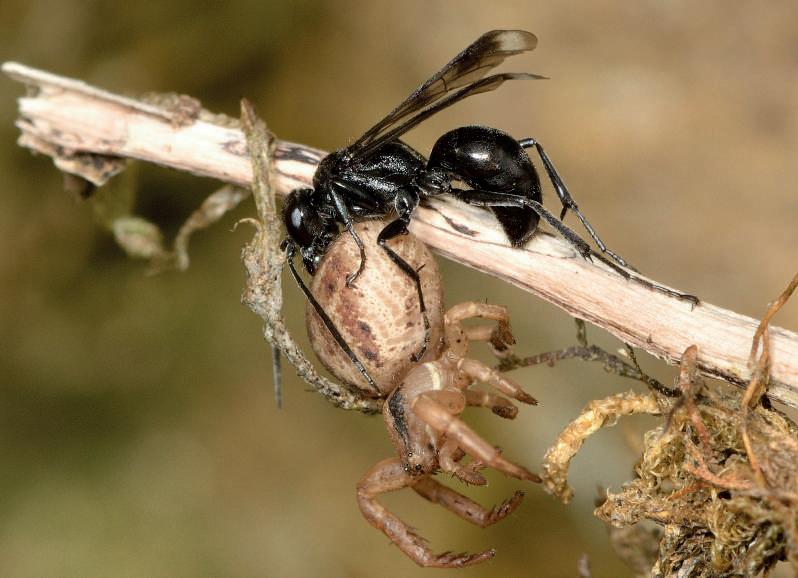
For the whole summer the wasps have been raising young, hunting for insects to feed them, but the adult wasps need nectar to survive – they can’t sustain themselves by stealing a bit of their grubs’ food, as a bee can. They have been grabbing a bit of nectar to sustain themselves when they could get it. Now the young are reared, and the wasps can relax, see the summer out in leisure, and grab some sugary food when they see it. They are on a short holiday before their deaths in autumn. For all the work they have done on your behalf, couldn’t you cut them a bit of slack?
Of course, it is wholly possible that the thing that is so upsetting you is not a wasp at all. Insects have many defence strategies to avoid being eaten, and one is to pretend you are something far more harmful than you are. This is known as Batesian Mimicry (after Mr Bates, who first described it). Consequently, there are quite a lot of totally harmless insects that have got themselves up in black and yellow stripes so that predators will leave them alone. Sadly, this doesn’t work with humans, who swat first and ask questions later.
There is, for example, a group of hoverflies that uses this camouflage trick. One is quite big and hornet-sized. Of course, gardeners love hover-flies, whose larvae eat aphids, and who are totally harmless to humans. Their flight-pattern and sound are quite different (wasps do not hover), and they have only one pair of wings (wasps have two pairs). Still, I admit that is a tricky bit of entomology to perform in a crisis situation.
For the whole summer the wasps have been raising young, hunting for insects to feed them
There is a wasp-beetle, that doesn’t admittedly look very wasp-like in shape or in flight, but is wearing the stripes. Look out for that one, it is moderately uncommon.
There is even a wasp-spider, quite a big lady, who is suitably striped. You would have to be a very poor naturalist to mistake her for a wasp, but it seems to work for her. You will find her in early autumn, sitting in her distinctive web in the long grass.
In fact, you could almost say that bees are mimicking wasps, because they can even fool intelligent, clear-sighted humans into doing the Wasp Fandango.
If you do sit out in the garden for a drink, or go for a picnic in late summer or autumn (and why would you, if you are that paranoid about insects) remember, you have entered wild territory, and you must adjust your thinking. And whatever happens, even if you are stung, panic is the worst possible response.























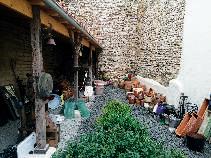














The month of May must surely mean some good weather? I know there is a popular French song about ‘Le muguet’ and ‘Le 1er mai’, but I prefer a different song. It goes along the lines of, ‘thank “beep” the rain has stopped, it’s been crap since October’. A little less catchy perhaps, but I feel that it captures the essence of the last 6 months. Anyway, onwards. Freesat is not the same as Freeview. If it has ‘Freeview’ written on the unit and you’re looking to get UK satellite TV, you’ve purchased the wrong box!
I’ve said this before and as I like the sound of my own voice, I’ll say it again.
Only in rainfall of biblical proportions should you expect to see the dreaded ‘no signal’ message when using a proper sized dish.
They are also rubbish when the time comes to replace the LNB - the bit on the end of the arm of the dish - as French ones don’t fit. This means you have to order one from the UK. Or, better still, replace the whole dish with something good.
Please do not consider using a region 1 Sky minidish
Please do not consider using a region 1 Sky minidish (the smaller of the two meshtype elliptical options) as they are rubbish. Yes they work, but they simply do not collect enough signal to be any good in bad weather. I attend many call outs to people with such dishes and the same thing is said every time. ‘You expect to lose the signal when it rains’. No. No you don’t.
For those interested in this year's Olympic Gamesfrom Paris no less - you will have a variety of options to watch. For those watching UK TV, then the BBC is the place to go. If watching via French TV, then the national broadcaster (France Televisions) has you covered. These are all free services. For those who prefer to watch via the internet, then Olympics.com has its own channel, enabling you to watch both live and past events. This is a good option to view events when you’re not at home.



Please remember that I no longer cover the same areas as I used to. I cover a 90 mins radius of 79240. Google Maps will help you with this.























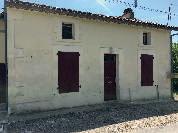



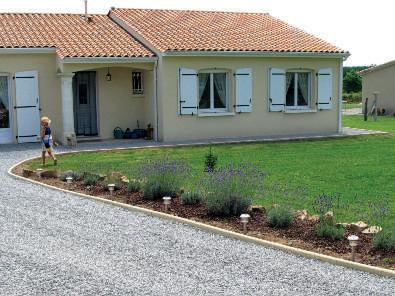






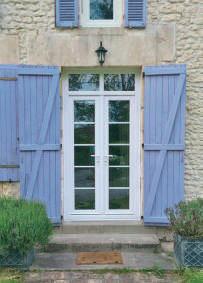










































Siret no. 493 159 412 00037


Siret: 80025145600011
English Scaffolding Service
Safe, secure, adaptable. Meets all safety regs. Covered by full public liability insurance. Delivered, erected, and dismantled Over 20 years’ experience. Free Quotes.
Depts 16, 87, part 24, 17, 79 & 86 Day: 07 85 44 26 66 / Eve: 05 45 66 49 87 martin.clare6@gmail.com


Saint-Junien. Covering Depts 87-16-24 Siret : 531 655 231 00 11 CONTACT: PAUL CHARLESWORTH T: 06 77 90 08 60 E: pmcbatiment@yahoo.fr Fully registered and insured Trading in France since 2007 Call Mark for a free quotation: T: 05 55 44 71 44 / M: 06 78 60 96 16 mumford.toiture@gmail.com


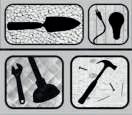
Davey
55 60 47 78 06 10 49 49 57 troy.davey@orange.fr siret: 49895173000015




























Family run business based in France which prides itself on a personal professional service.
7 tonne truck to and from the UK and Europe, we also have a box trailer for larger loads.
Our highly experienced staff provide a door to door service with packing and dry secure storage We arrange customs clearance for export and import to and from the UK. We are a professional furniture removal company NOT a man and a van. Phil and Jean Evans (+33) 05 55 34 19 46 Mobile (+33) 06 80 75 87 14
Email p.evans@orange.fr Visit www.transitionremovals.net











av Henri Barbusse,
Saint Junien Service Immobilier: 05 55 02 11 11 email: immo@courivaud.com site: www.cmvnotaires.com




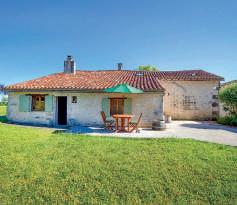









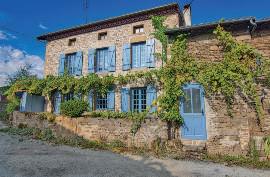




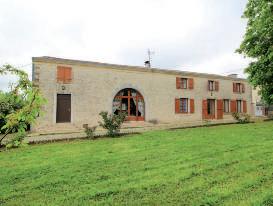
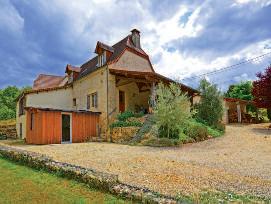






























































● Wood and pellet boilers
● Air conditioning
● Solar panels
● Wood or pellet burning stoves
● Air source heat pumps
● Radiators
● Solar hot water systems
● Thermodynamic water heaters
● English speaking ● Free energy assessment of your home
● Government grants deducted directly from quotations
● Assurance Décennale, (10-year Guarantee)
